|
Santa
Caterina di Saragozza |
||
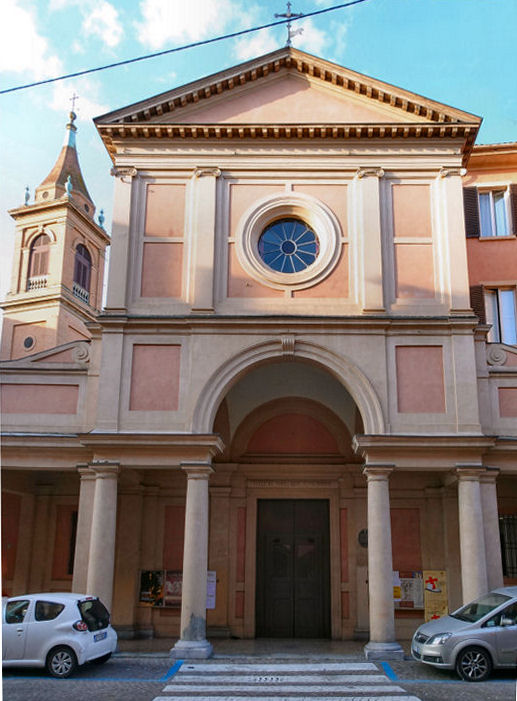 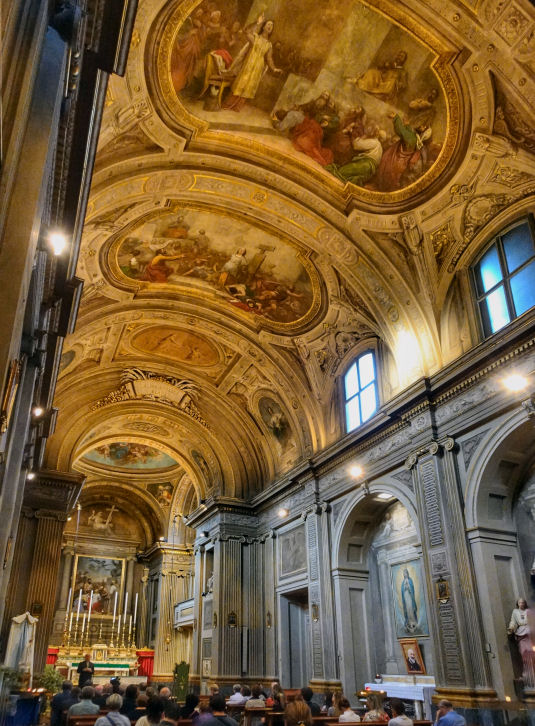 History A church here dedicated to Saint Catherine of Alexandria dates back to at least the 12th century, and is called di Saragozza because of the street name. It probably began as an Albergati family chapel with the church remaining under their patronage until 1895, when Francesco III Albergati Capacelli Gini, the last of the line, died. There was major rebuilding in 1443. The main entrance facing Via Santa Caterina was turned towards Via Saragozza and a porch added. Between the 17th and 18th centuries the church acquired relics, including the body of Saint Maurice (still here, in an urn), and a miraculous image of the Virgin. In 1776 the roof was restored at the expense of the patrons of the chapels. In the 18th century the church gave refuge to ex-Jesuits from South America, following their expulsion from Spain and its South American colonies in 1767. Some of them were buried here, including Juan Ignacio Gonzales of Guadalupe, whose image was placed on the altar dedicated to Saint Catherine. The Parish also became the seat of the Brotherhood of the Blessed Virgin of Guadalupe and to this day the 12th of December, the anniversary of the apparitions of the Virgin to Juan Diego, is celebrated here. Rebuilt in 1816, still paid for by the Albergati family, and by the parishioners, with reconsecration on 12th October 1817. A new campanile was completed in 1824. In 1863 restoration work was carried out on the fašade. During this work a 16th-century fresco of the PietÓ was found, attributed to Biagio Puppini delle Lamme, now to be found in the first bay on the right. It is reported that from 1864 a local painter Alessandro Guardassoni replaced all the paintings on all the altars, demanding no payment. Around the same time the marble worker Carlo Vidoni created the high altar, the marble steps of Verona marble, the four altars of the side chapels and two holy water fonts in Carrara marble.
Interior |
||
|
Santa Caterina di Strada
Maggiore Strada Maggiore |
||
|
History A Benedictine monastery and church called Santa Maria del Torlione may have been here as early as 1144 until 1458. A monastery of Vallombrosan nuns founded by Barbara Orsi in 1522 opened their church in 1605, which suppressed in 1796 and the church closed in 1805 but reopened 20 years later. Complex used by charity helping the poor. The original church is now the sacristy. The portico was added by P. Fiorini in 1612 and restored in 1832 by E. Gasparini. On the fašade are 19th century statues by A. Franceschi, G. Putti, L. Roncagli. Interior 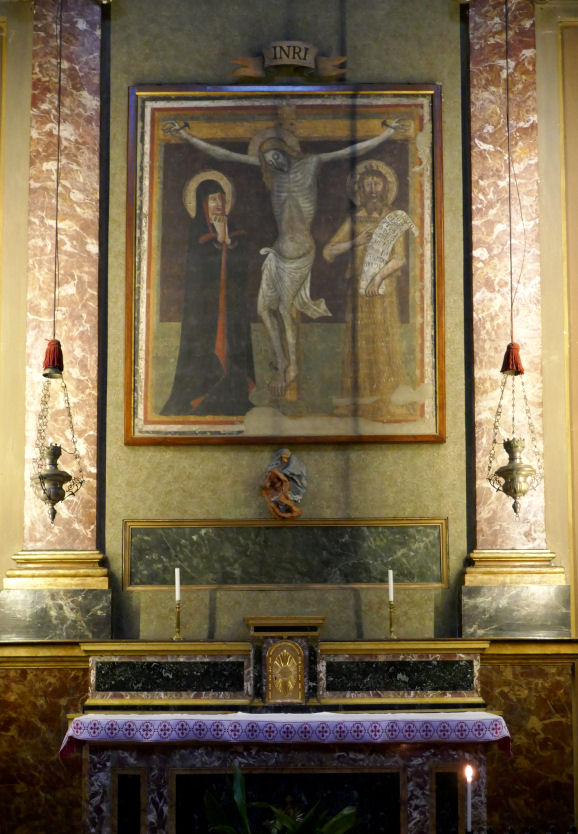 Dark, big and aisleless, with four chapels each side, all well illuminated. Mostly 18th century paintings by Alessandro Calvi (an unusual Saint Joseph and Child in the last chapel on the right), A. Dardani, and U. Gandolfi. The 19th-century presbytery is by A. Guardassoni and GB Baldi. Also a late 14th century Crucifixion detached fresco panel in the second chapel on the left (see left) may be by Simone dei Crocifissi, (but even the church's information panel says Maniera di). It has been here since 1962, coming from the Palazzo Magione of the Knights Templar. A Guardian Angel with Saints Sofia & Simon and Tobias(?) by Francesco Gessi, restored in 2009, is in the last chapel on left. Campanile By F. Antolini (1842). Opening times 7.30 - 12.00 & 5.00 - 7.00
|
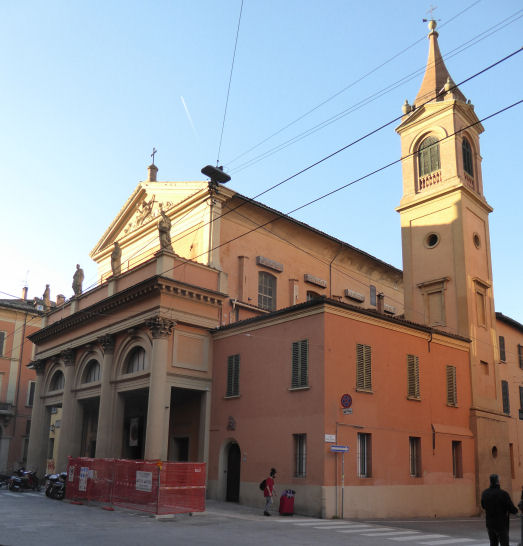 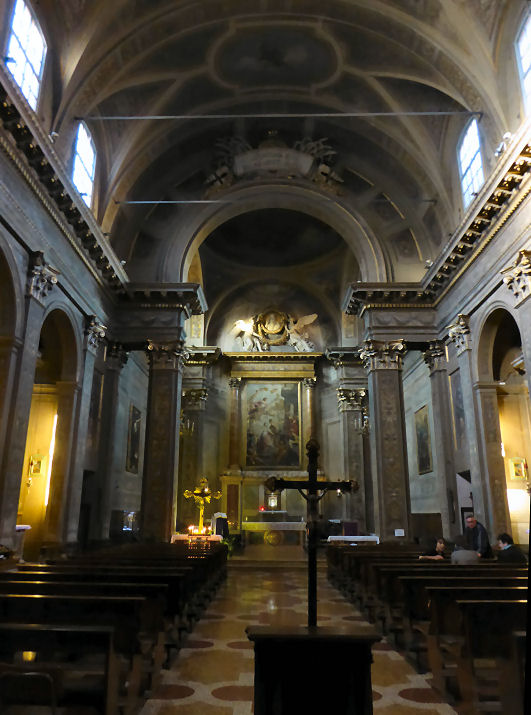 |
|
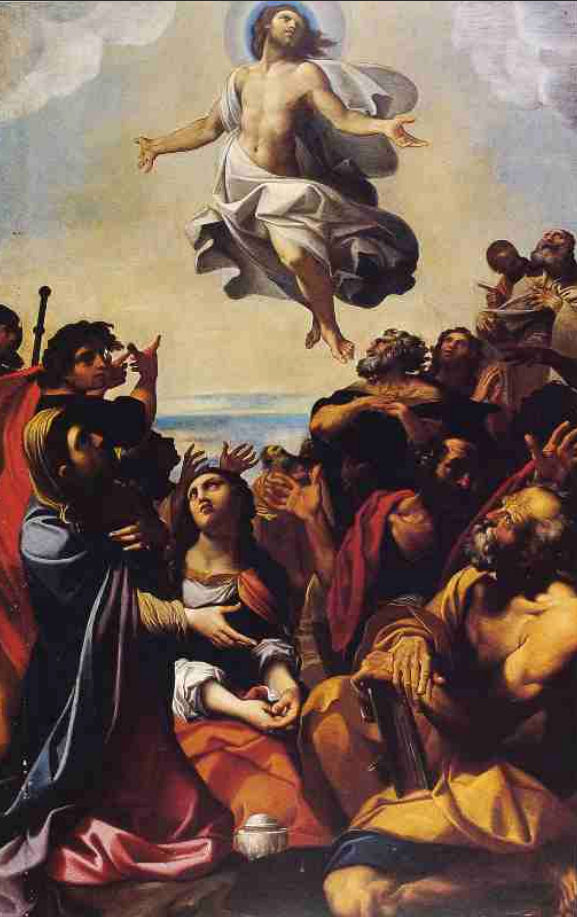 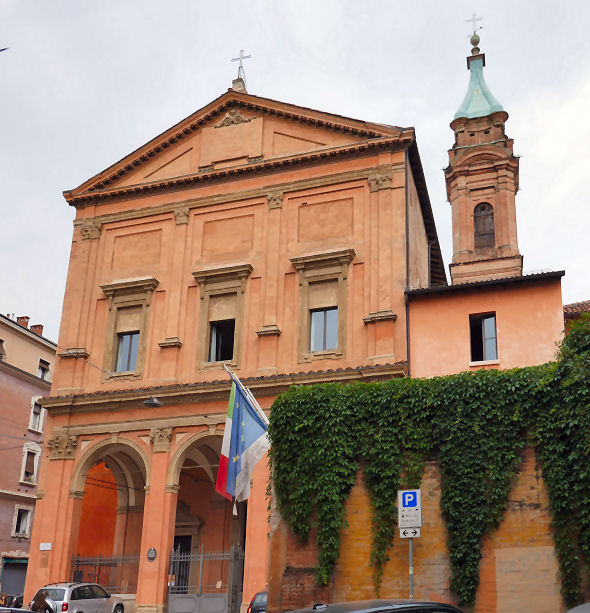 History The original church dates to 1247 when Camaldolese nuns founded the convent of Santa Cristina della Fondazza. The current church dates to rebuilding of 1602 by Giulio della Torre, a pupil of Domenico Tibaldi. Suppressed by Napoleon, after Italian unification the church became a military warehouse when the complex became a barracks. After restoration, in 2007 the church reopened for use as a concert venue and is also the headquarters of the Schola Gregoriana Benedetto XVI, which teaches Gregorian chant. The convent complex has since 2004 housed the Department of Visual Arts of the University of Bologna. It has a late-15th-century cloister and is also home to a women's centre and the Biblioteca Italiana delle Donna, the leading women's library in Italy. Fragments of frescoes remain, including a Crucifixion attributed to 'the school of Lorenzo Costa' in the refectory, which is now a lecture hall. Interior Four chapels each side of an aisleless nave. Many 16th and 17th century Bolognese paintings, including The Adoration of the Shepherds by Giacomo Raibolini, The Ascension by Ludovico Carracci (over the high altar) (see left), a Visitation by Lucio Massari and a Sacred Conversation by Francesco SalViati. This latter work, of 1540, was painted by SalViati whilst he was in Venice and shows the Virgin and Child flanked by Saints Christina of Bolsena, John the Baptist, Philip, and Nicholas of Myra. Kneeling before them are Saints Romuald and Lucia Settefonti, the founder of the Camaldolese order and a locally venerated saint also from the order respectively. A preparatory study for the painting is in the Linz Nordico Stadtmuseum. Statues of Saints by Giuseppe Mazza, Giovanni Tedeschi and Guido Reni. The latter's two works - Saints Peter and Paul - being said to be the only sculptures by the painter. Lost art Six panels of 1329 showing An Angel and Two Saints, The Martyrdom of Saint Christine, The Vision of Saint Romuald, Saint Gregory in his Studio, The Death of the Virgin and An Angel and Saints Luke and Paul by the Pseudo-Jacopino, are in the Pinacoteca.
Campanile
Part of the
Genus Bononiae -
Museums in the City cultural itinerary/walk,
it's just that you can't actually get inside! |
||
|
Santa Lucia Via Castiglione |
||
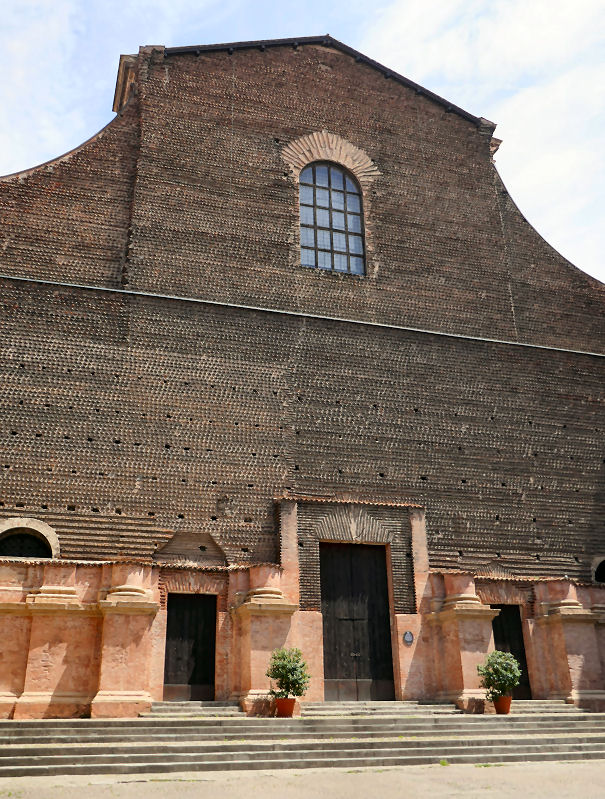 History A church is said to have been here since 432, named by San Petronio himself. It was ruined in the Hungarian invasion of 903 and rebuilt in 1208 by the Order of Canons Lateran who remained here until 1418. In the 16th century the abandoned church and convent passed to the Jesuits, who rebuilt the church. The wealthy women of Bologna became very devoted to the Jesuits, particularly the widows Margherita dal Giglio and Violente Gozzardini. This devotion came to head in the 1540s when on one occasion the church had to be closed during confession because it was so packed with women. From 1623 the interior was reworked by Girolamo Rainaldi inspired by the design of the mother church of the Jesuits, the Ges¨ in Rome. In 1775 the Jesuits were suppressed and the complex was briefly occupied the Barnabites before suppression by Napoleon. Now deconsecrated used as the Great Hall by the University of Bologna. Interior Has a chapel dedicated to St Louis Gonzaga with an altar (1763) designed by Alfonso Torreggiani. Lost art The Crucifixion with the Women at the Bottom of the Cross from the early 1580s, by Prospero & Lavinia Fontana, painted for the Balzani chapel this church, is now in Sant'Antonio Abate. Its subject supposedly reflects the eager support and money given to the Jesuits by wealthy Bolognese women, particularly widows, but Crucifixion scenes with many Marys at the base the cross are hardly uncommon. The painting was for the Balzani chapel here, and the figure at the left edge may be Paolo Emilio Balzani, who may have commissioned the painting. Three paintings by Lorenzo Sabbatini, a Circumcision, Saints Domenic and Petronius and the high altarpiece, believed to be the Virgin and Child with Saints Agatha and Lucy, now also in Sant'Antonio Abate. Along with Saint Vincent by Orazio Sammachini and two Madonnas by Denis Calvert. The Procession of Saint Gregory the Great by Federico Zuccaro came here after it was rejected by Paolo Ghiselli for his family chapel in Santa Maria del Baraccano but is now known only from a finished drawing. The Virgin and Child with Saints Teresa, John the Baptist and Carlo Borromeo by Carlo Cignani, of 1680, from the DaVia chapel here, now in the Pinacoteca. Opening times Publicised times are Monday to Friday 8.30 - 1.30 & 2.30 - 5.30 but they seem to bear scant relation to reality. |
||
|
Santa Maria degli Angeli Via degli Angeli |
||
|
History There had been a small chapel on this site in 1300, dedicated to the Magi, built in imitation the shape of the manger in Bethlehem and for this reason called Santa Maria del Presepio. Inside was a wooden statue of the Virgin and Child Blessing which in the early 15th century began performing miracles. The bishop of Bologna at the time, Giovanni di Michele (1412 to 1417) made plans to have it translated to the cathedral of San Pietro, but when the procession reached Via Orfeo the men carrying the statue were blinded and began to stagger. This was taken as a sign that it did not want to be moved and so he bishop then ordered that it be taken back. This episode led to calls on the new bishop Niccol˛ Albergati (1417 to 1443 and famously painted by Jan van Eyck ) to make the chapel here into a church. He also installed a lay brotherhood dedicated to the care of needy and abandoned children, named after Santa Maria degli Angeli, which led to the renaming of the church, built in 1474 by Gaspare Nadi. The confraternity was suppressed by Napoleon in 1798 but the church remained open, but closing in the early 1900s. The miracle-working statue of the Virgin was transferred to San Giuseppe e Ignazio up the road. The deconsecrated church is now used by art restorers and called LabOratorio degli Angeli.
The church
|
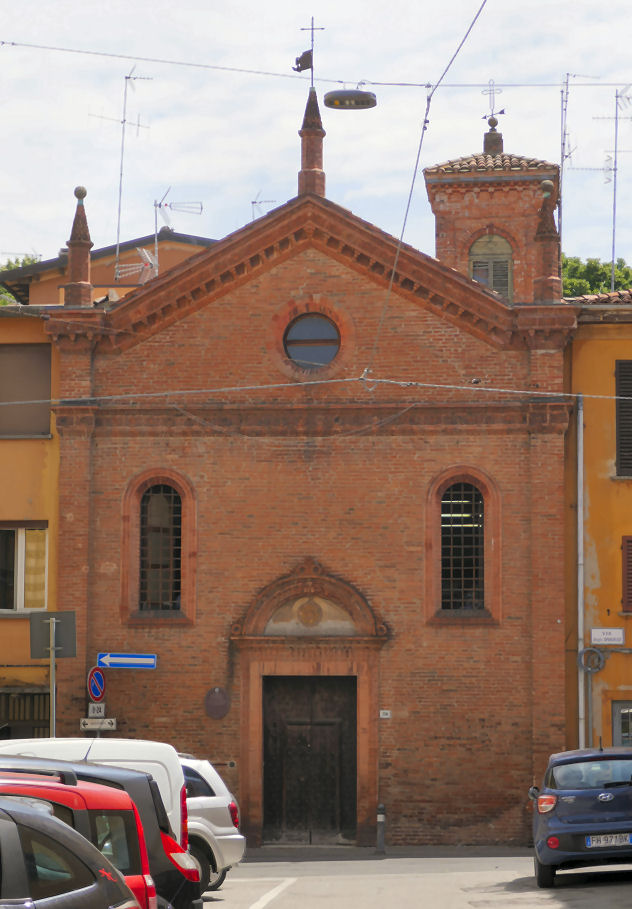 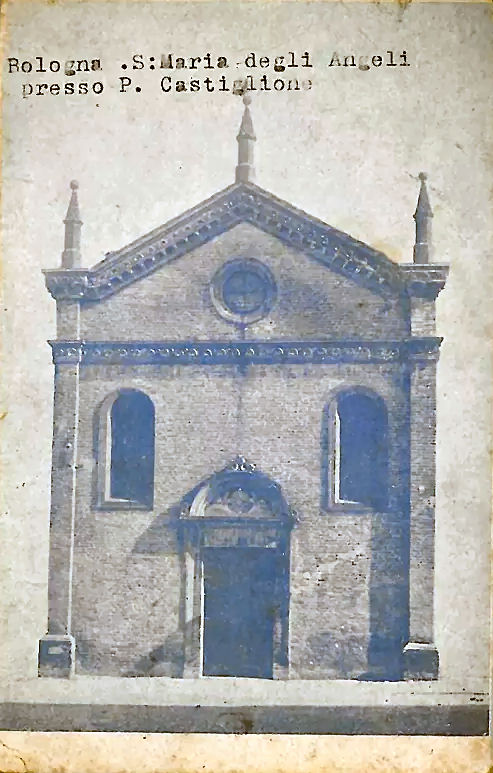 |
|
|
Santa Maria dei Bulgari
Piazza Galvani |
||
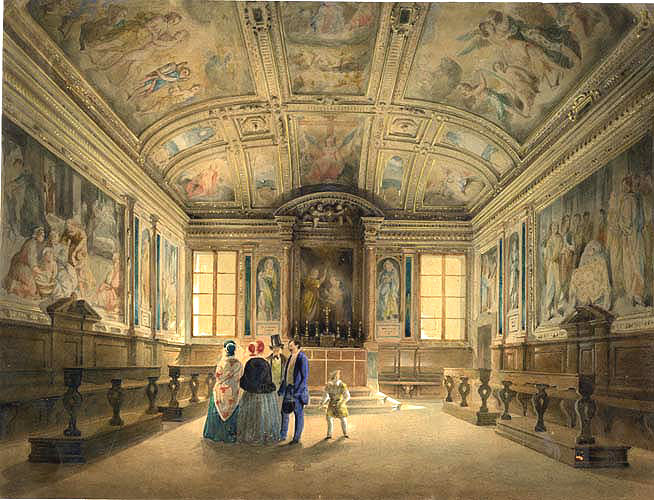 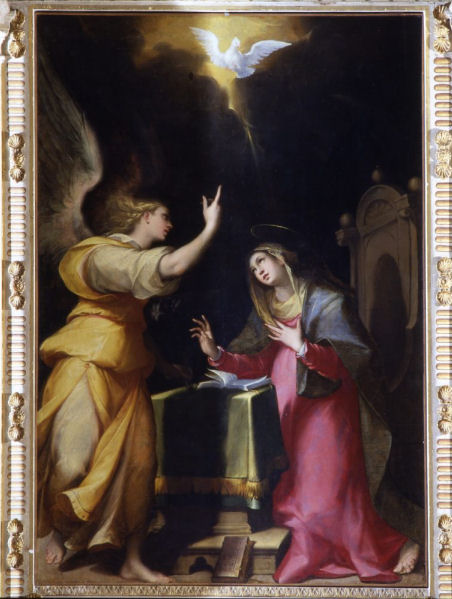 History The late-16th-century chapel within the Archiginnasio, the university building which also houses the anatomical theatre and library. Interior The chapel has fragments of a fresco cycle of The Life of the Virgin by Bartolomeo Cesi, painted 1591/94. These remains are what's left after allied bombing on January 29th 1944. There are black and white photos of Cesi's frescoes and vault panels from before the destruction. The high altarpiece is an Annunciation by the Flemish painter Denis Calvert from 1582. Rarely open.
|
||
|
|
|
|
|
History Named for the baraccano (barbican) in the walls that overlooks the church. Around 1327 a fresco of the Madonna della Pace, questionably once attributed to Lippo di Dalmasio, was painted on the interior of the city wall. In 1401 Bologna was besieged by Gian Galeazzo Visconti, hoping to overthrow the Bentivoglio. In January 1402 Bente Bentivoglio, a cousin of Giovanni I Bentivoglio, spotted an old woman called Francesca Vinciguerra praying in front of this Virgin. Suspecting her of being a spy passing letters through holes in the wall he had her arrested and the image bricked up. The covering wall collapsed, was rebuilt, and collapsed again. So Bente freed the old woman and in 1403 built a small semi-hexagonal chapel against the wall around the image. As the image continued to work miracles this chapel was enlarged in 1418 with the addition of a tile and wood portico. In 1472 the miraculous Madonna was repainted by Francesco del Cossa, leaving the original faces of the Virgin and Child. A more recent, and more convincing attribution for the painter of the original holy faces is to the Pseudo Jacopino, or his circle. In 1512, during the siege of Bologna by the troops of Pope Julius II, a Spanish commander exploded a mine against the wall here. The explosion blew up the chapel, so that the two armies faced each other through the hole, but the hole miraculously healed itself, with the image of the Madonna unharmed, so increasing local devotion and the image's election as protector of the city. It is also known as the Madonna of War. The church and current portico date to rebuilding of 1524 and 1550 respectively. In 1682 the dome was added Agostino Barelli. Suppressed by Napoleon on July 27th 1798 but it managed to remain open by being declared a sanctuary. Originally attached to a pilgrim hospital that later became a school for needy girls. The porticos Opposite the church's fašade, across the car park, is the Great Vault, a portico built from 1497 to 1524, commissioned by Giovanni Bentivoglio to further the cult of the Madonna drl Baraccano. It's appearance during the Renaissance can be appreciated from the 18th-century engraving by Panfili (see right). It connects with the portico built to protect access to the Ospedale dl Baraccano, stretching down to Porta Santo Stefano., begun in 1491, again at the instigation of Giovanni Bentivoglio. The church The fašade portico built in 1524. The tympanum with statues of the patron saints of Bologna - San Petronio, San Domenico, San Procolo and San Francesco - is attributed to Sperandio Savelli. In the centre of the tympanum, in a niche, is a terracotta statue of the Virgin by Alfonso Lombardi. The dome was built in 1682 by Agostino Barelli. 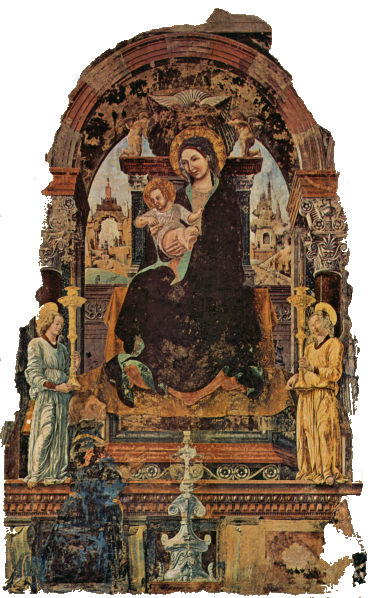 Interior Restored in 1914 to debaroquify and return the church to its 16th/17th-century appearance. The early-14th-century miraculous fresco of the Madonna della Pace (or Madonna del Baraccano) whose history is detailed above, was retouched, with a classicising frame added, in 1472 by Francesco del Cossa, commissioned by the Bentivoglio, with Giovanni I kneeling below, and is now over the high altar. It was detached from the city wall in 1969 by Ottorino Nonfarmale. The bottom layer is a sinopia showing St Nicholas of Tolentino gesturing towards a donor whose praying hands only remain. Cossa's additions do not exactly blend in harmoniously (see right). This was one of his first works in Bologna following his flight from Ferrara following Duke Borso d'Este's refusal to up his wages for his work on the Palazzo Schifanoia. In the Orsi chapel is a Holy Family by Lavinia Fontana and in the Hercolani chapel is The Disputation of Saint Catherine of 1551 by her father Prospero. This latter scene, not often depicted on altarpieces, precedes the famous ordeal on the wheel and shows the saint arguing with fifty pagan philosophers. She converts them and they all get thrown into a fire, only to miraculously survive. In the Ghiselli chapel is the Miraculous Procession of Gregory the Great by Bolognese artist Cesare Aretusi, in collaboration with Giovanni Battista Fiorini. It was commissioned in honour of the reigning Pope Gregory XIII for his family chapel here, after a work on the same subject painted by Roman artist Federico Zuccaro was rejected on unrecorded grounds, but the presence of a pile of naked plague victims may be crucial. The rejected work ended up in the Jesuit church of Santa Lucia. Opening times Saturday 11.00 - 13.00 Sunday 10.00 - 12.30 |
|
|
|
Santa Maria della Carita Via San Felice |
||
|
History By the mid 13th century there was a hospital here, which later became an orphanage. A hospital chapel existed by 1378. From 1468 the church and convent here were run by Franciscans. The present church dates from a rebuilding of 1583, to designs by Pietro Fiorini. It was enlarged, with four large chapels added, in 1680 to designs by Giovanni Battista Bergonzoni, a Franciscan theologian. 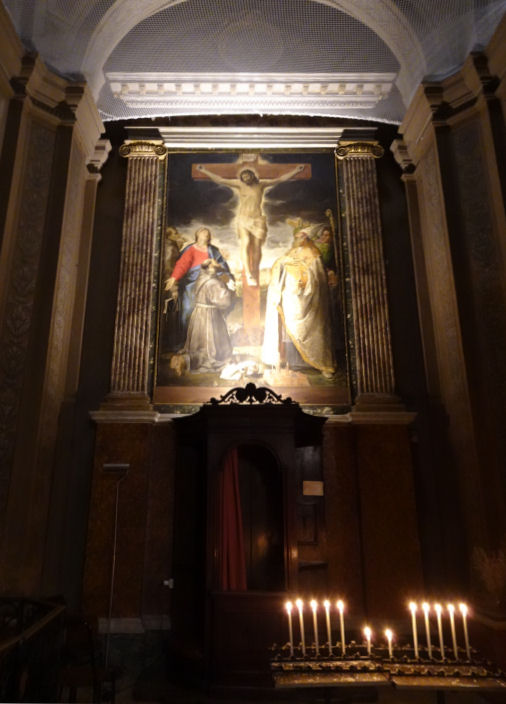 Interior Greek-cross shaped, but with a long presbytery, dark with netting masking the vaulting (in October 2019) and catching bits of it, presumably. Chapels in the corners. Much work by baroque painters. The first chapel on the left has an early work by Annibale Carracci, a well-lit panel over a confessional depicting The Crucifixion with the Virgin and Saints Francis, Bernardino John the Baptist and Petronio of 1583 (see right). The painting was originally in the church of San Nicol˛ di San Felice, now a wreck just up the road. The chapel in the corner to the left of the presbytery has an unlit Holy Family with Saint Anthony of Padua (1680) by Felice Cignani. The first chapel on the right has a Visitation by Il Galanino. In the third chapel on the right is a Vision of Saint Elizabeth (1685) by Marc Antonio Franceschini. The tall and handsome sacristy to the left of the presbytery was also designed by Bergonzoni and has paintings by Gaetano Gandolfi, Jacopo Alessandro Calvi, and sculptures by Giovanni Francesco Bezzi. To the right of the presbytery is a small oval top lit chapel. Other artists with work here, mostly randomly placed on the counter-fašade, include Giovanni Valesio, Flaminio Torre (A Virgin and Saints), Antonio Crespi, Luigi Quaini, and Luigi Crespi. Also a Virgin and Child with Charity and Saint Francis by Cesara Aretusi and Giovanni Battista Fiorini which is rare for featuring a painted personification of Charity, but appropriate given the name of the church.
|
|
|
|
Santa Maria della Misericordia Piazza di Porta Castiglione |
||
|
History Cistercian nuns had been here in 1150, but Olivetan monks from San Michele in Bosco built this church from 1431, before being replaced by Augustinians in 1473 who added the portico and nave chapels. The present portico in front of the fašade is 18th century. Interior A nave with two aisles, very dark and label-free, with brick columns topped by carved stone capitals and fresco decorated arches and vaulting. Five chapels each side, small and shallow on left, tall and deep on the right, then the transept and a wide shallow apse with a high altarpiece on the back wall of The Adoration, a copy of the original by Francia, which is now in the Pinacoteca. Francia did much work for this church. 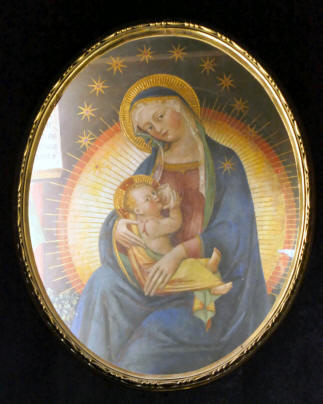 The second chapel on the right has a 1397
Virgin and Child (The Madonna of Consolation)
by Lippo di Dalmasio in a lit box behind an oval window (see
right) with a framing structure by Formigine. The window
above is a Virgin and Child Enthroned designed by Francesco Francia
from 1499.
The fifth chapel has a Pentacost by
Bartolomeo Cesi and the sixth, the Felicini has another rose window designed by
Francesco Francia, this time depicting Saint John the Baptist
and an Annunciation
by Gaetano Gandolfi. The second chapel on the right has a 1397
Virgin and Child (The Madonna of Consolation)
by Lippo di Dalmasio in a lit box behind an oval window (see
right) with a framing structure by Formigine. The window
above is a Virgin and Child Enthroned designed by Francesco Francia
from 1499.
The fifth chapel has a Pentacost by
Bartolomeo Cesi and the sixth, the Felicini has another rose window designed by
Francesco Francia, this time depicting Saint John the Baptist
and an Annunciation
by Gaetano Gandolfi.Lost art in the Pinacoteca by Francesco Francia An crowded square Virgin and Child Enthroned with Saints John the Baptist, Monica, Augustine, Francis, Proculus, and Sebastian, with a Felicini Donor and a Musical Angel of 1490. It is an early work by Francia, Vasari says it was his first, and was commissioned by Bartolommeo Felicini in thanksgiving for his recovery from illness. The possible predella scenes of The Nativity, The Baptism of Christ, and The Stigmatization of Saint Francis are in the Kelvingrove in Glasgow (in storage), the Gulbenkian in Portugal and lost respectively. Also a smaller Pieta with two angels, also painted for the Felicini chapel here. A 1490 Virgin and Child Enthroned with Saints Augustine, George, John the Baptist, Stephen and an angel, painted for the Manzuoli chapel here. A predella showing The Adoration of the Shepherds and The Vision of Saint Augustine of 1508 painted for the Zambeccari chapel here, in the latter episode Saint Augustine has visions of the Virgin Lactans and the Crucifixion and can't decide between the milk or the blood. This odd scene, of which this may be the earliest depiction, is derived from a text then thought to be Augustine but later found to be apocryphal. An Adoration with Saints Joseph, Augustine, Francis and two angels with Anton Galeazzo Bentivoglio and Alessandro Bentivoglio of 1498. It has some involvement from Lorenzo Costa and is said to have been completed in two months. Its predella is in the Brera. In the main panel (see below right) Monsignor Anton Galeazzo Bentivoglio is to the left of the Virgin, with his patron saint, Anthony of Padua, behind him. Saint Anthony is traditionally said to be a portrait of Francia. The handsome figure to the right, dressed as a shepherd and crowned with a laurel wreath, is Girolamo Casio, a wealthy merchant and skilled goldsmith with political ambitions who was also a writer of inferior verse. He courted the powerful too, and corresponded frequently with Isabella d'Este, who used him as her artistic agent in Bologna. In the Cappella Gozzadini was a predella panel showing The Nativity, Infancy and Crucifixion. Lost art not by Francia in the Pinacoteca A Mystic Marriage of Saint Catherine by Giovanni Battista Ramenghi (Bagnacavallo Junior) , from c.1545 and painted for the Scala chapel here. Lost art not in the Pinacoteca The Virgin and Child with Saints John the Baptist and Sebastian, the Pala Casio was painted by Giovanni Antonio Boltraffio in 1500 for the poet Girolamo Casio who was a major patron of Boltraffio and mentioned him in some of his sonnets. The poet's father, Giacomo Marchione de' Pandolfi da Casio, kneels to the group's left, the man himself is to the right. It is now in the Louvre, following a trade with the Brera in Milan in 1812. Boltraffio was until very recently thought to be the painter of the controversial disappearing Salvator Mundi, controversially ascribed to Leonardo, and sold for a very substantial amount of money.
Opening times
|
|
|
|
Santa Maria della PietÓ (dei Mendicanti) Via San Vitale |
||
|
History Built from 1601 for the very popular Opera della PietÓ dei Mendicanti, who cared for the poor. An orphanage was established on January 20th, 1567, when orphans from San Gregorio outside Porta San Vitale were moved here. In 1598 some houses were bought to be demolished to build the church, for which work begun on June 30th 1600. The vault paintings by B. Belli date to 1667, the portico to 1691. Interior Tall and boxy, plain and aisleless, with five chapels each side, the middle ones much taller. Bartolomeo Cesi painted the 1625 Crucifixion with Saints John the Evangelist, Anthony of Padua, Nicholas of Tolentino and Francis in the first chapel on the left (the Lini chapel and the Ecstasy of Saint Anne in the second (the Zamboni), which was also painted in 1625. Lavinia Fontana's impressive Miracle of the Loaves and Fishes of c.1600 is in the central tall chapel on the left, having replaced Guido Reni's San Giobbe Altarpiece. 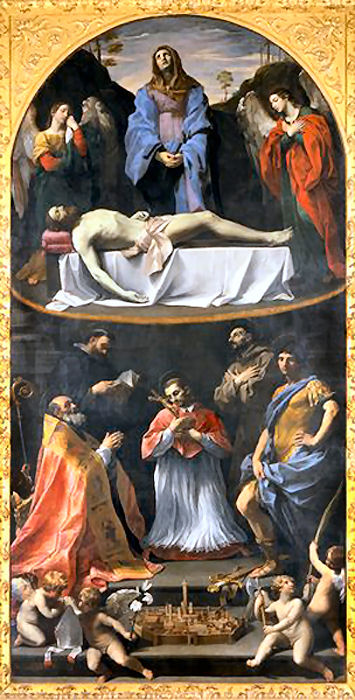 The first chapel on the right has a 1570 Saint Ursula by Bartolomeo Passerotti, Ercole Graziani painted the Death of San Francis in the middle chapel on the right, from the suppressed church of Sant'Ignazio. In the last chapel on the right is The Charity of Sant'Eligio by Alessandro Tiarini and an Annunciation by Luigi Valesio. Lost art Lots looted by Napoleon. A Calling of Saint Matthew by Ludovico Carracci of c.1607 painted for the chapel of the Compagnia dei Salaroli here. A Virgin and Child in Glory with Saints Al˛ and Petronius from 1614 by Giacomo Cavedoni, commissioned by the Compagnia dei Fabbri. The famous huge high altarpiece, The Pieta with Saints Petronius, Francis, Dominic, Proculus and Charles Borromeo (the Pala dei Mendicanti) (see right) by Guido Reni was commissioned by the Bologna Senate and installed on the high altar here on the 3rd of November 1616. It was looted by Napoleon in 1796, as were the other two works just mentioned, but all three were returned and are now in the Pinacoteca. A copy of the Reni altarpiece by Clemente Alberi was put in the church. No fewer than seventeen preparatory sketches exist for this painting, in various collections. Reni also painted the San Giobbe Altarpiece for the third chapel on the left in this church, but it was not returned and is still in Paris, in N˘tre Dame. The Dream of Saint Joseph by by Alessandro Tiarini remains in the Louvre too. Opening times 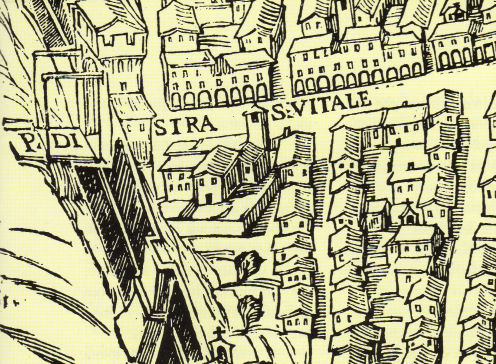 Monday to Saturday 7.30 - 11.30 & 4.30 - 6.45 Sunday 7.30 - 12.30 |
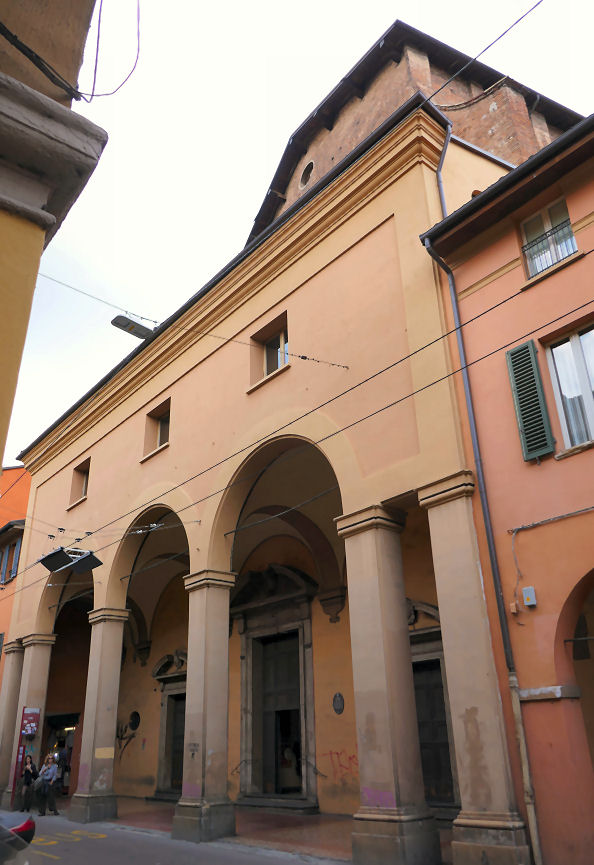 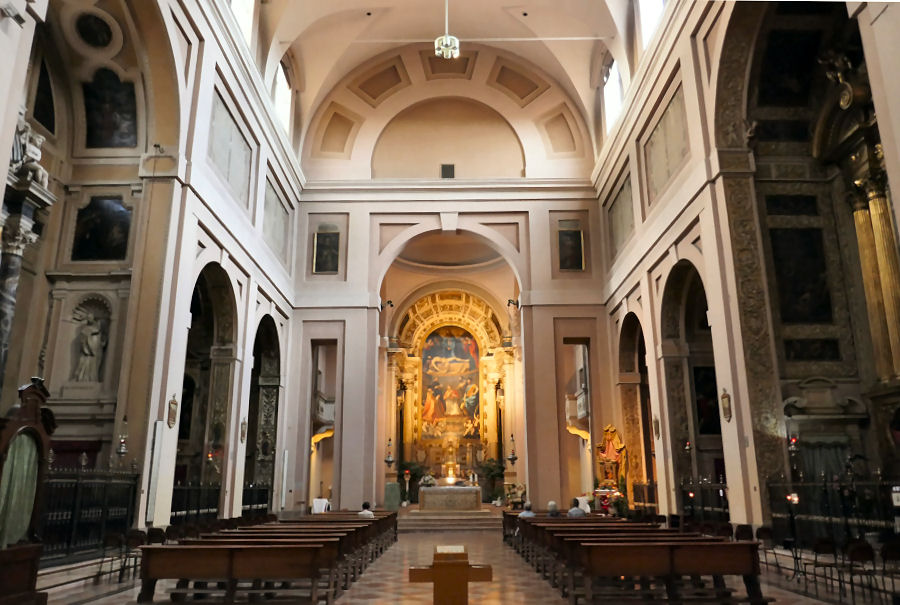 |
|
|
Santa Maria della Pioggia San Bartolomeo di Reno Via Riva Reno |
||
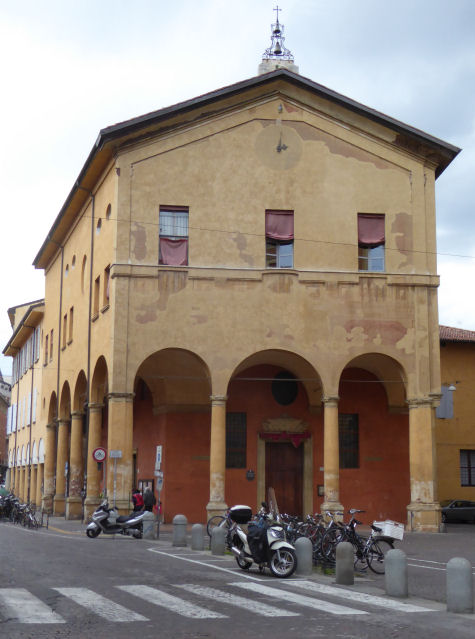 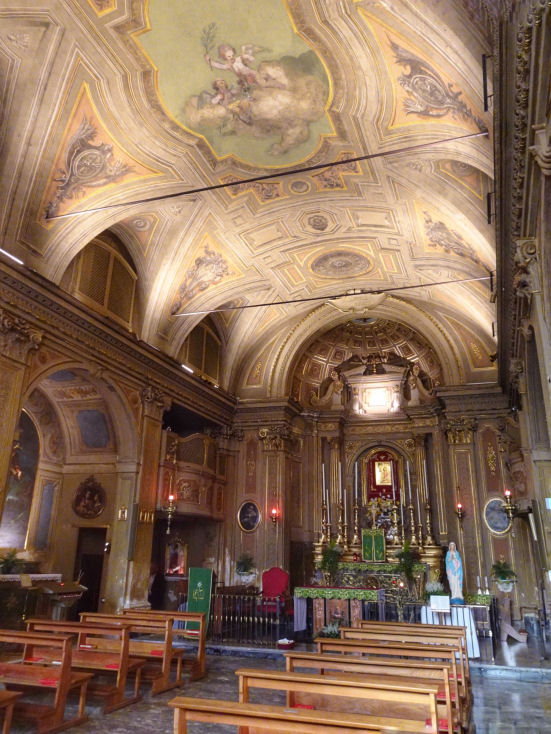 History Originally 13th century and known as San Bartolomeo di Reno as the Reno canal (now concreted over) ran next to it. Rebuilt in 1536, and in 1730 by Alfonso Torreggiani. The church was renamed Santa Maria della Pioggia (the Madonna of the Rain) for a miracle-working Madonna, still here, of the Virgin and Child with Seven Heads of Angels, attributed to the 15th-century painter Michele di Matteo, which brought rain after being processed during a draught in 1561. It's said that it was also found intact under the ruins of a palace destroyed by fire and that it healed a blind man. The building was recently restored and now houses the Pii Istituti Educativi. Interior The 19th-century interior is by F.M. Zanotti. A squarish space, beige with gilding, an aiseless nave with three chapels each side and a decorative frescoed vault. Nun's galleries where the clerestory windows should be and, more ornately, either side of the presbytery where the miracle-working Madonna is to be found. There are unlabelled, mostly modern, paintings. There are also a Circumcision (not found by me) and an Adoration of the Shepherds of 1584 by Agostino Carracci. The latter is in the first chapel on the left, and was visibly damaged by bombing. Also a Virgin and Child Enthroned with Saints Catherine and Lucy by Lorenzo Sabbatini in the first right chapel. The stucco work is by G. Fiorini and there are works by Felice Pasqualini, Francesco Monti and Ercole Graziani An oratory on the first floor, belonging to the fellowship of San Bartolomeo, reportedly has an 18th century staircase, a Landscape with Saint Bartholomew by Ludovico Mattioli, 16th century paintings and an odd clay sculpture of Saint Bartholomew by Alfonso Lombardi.
Opening times |
||
|
Santa Maria della Visitazione
al Ponte della Lame Via Lame |
||
|
History This church, dedicated to the visit of the Virgin to Elisabeth, the mother of John the Baptist, dates back to the plague of 1527. A much-venerated image of the Virgin and Saints John the Baptist and Sebastian in a tabernacle on the nearby bridge, the Ponte della Lame, was believed to have kept the worst of the plague at bay and so a church was built around it, managed initially by the Confraternita dei Devoti and later, from 1764, by the Confraternita dei Poveri di San Rocco.
The church in art
Opening times
|
|
|
|
Santa Maria della Vita Via Clavature |
||
|
History The original church was built in 1260 by Riniero Barcaboni Fasani from Perugia, founder of the flagellant ConfraternitÓ dei Battuti Bianchi and dedicated to the Virgin, being called Saint Mary of Life due to the brotherhood's hospital attached to it, which remained the city's main hospital up to the 18th century. Enlarged between 1454 and 1502, the church was rebuilt by G.B.Bergonzoni in 1692 after the ceiling collapsed in 1686.. The dome was added, to a drawing by Antonio Bibiena, by Giuseppe Tubertini in 1787. The facade dates from 1905. Interior A noisy city-centre open-door space, centrally-planned and elliptical inside, quite pale and light and sparse with the gilding. Deepish chapels in the corners with wider spaces on the north and south sides, both blocked by metal racks of 'inspirational' modern art in 2018. The dome is frescoed by Gaetano Gandolfi. A fresco of the Virgin Enthroned by Simone de' Crociffissi was saved from the 17th-century collapse. Two chapels flank the big marble high altar, on which is a fresco from the second half of the 14th century of the Madonna della Vita. The right hand chapel has the famous terracotta sculpture group of the Lamentation over the Dead Christ (The Compianto) of 1463, by Niccol˛ dellĺArca (see photo below) contemporary with the church's enlargement. Niccol˛ was named for his considerable contribution to the arca (tomb) of Saint Dominic in San Domenico. Commissioned by the Confraternity, it consists of seven life-size figures - the Virgin and the Three Marys, Saint John the Evangelist and Joseph of Arimathea - which were originally polychrome and since the earthquake in 2012 have been protected by scaffolding. You now have to pay Ç3 at a tubular plastic cash desk to see the Lamentation group, now cunningly hidden by a screen. Opening times Daily 10.00 - 7.00, closed Monday 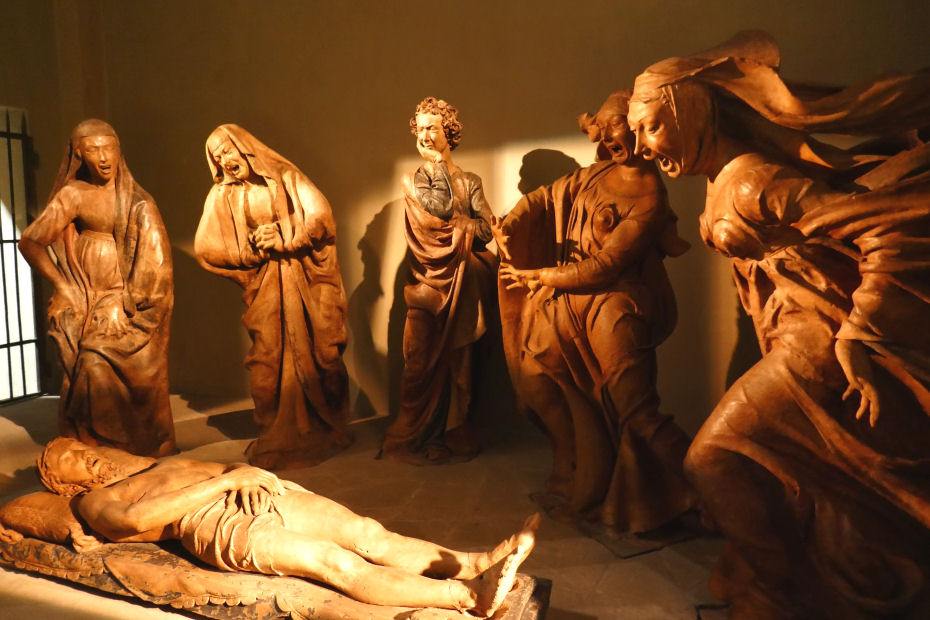 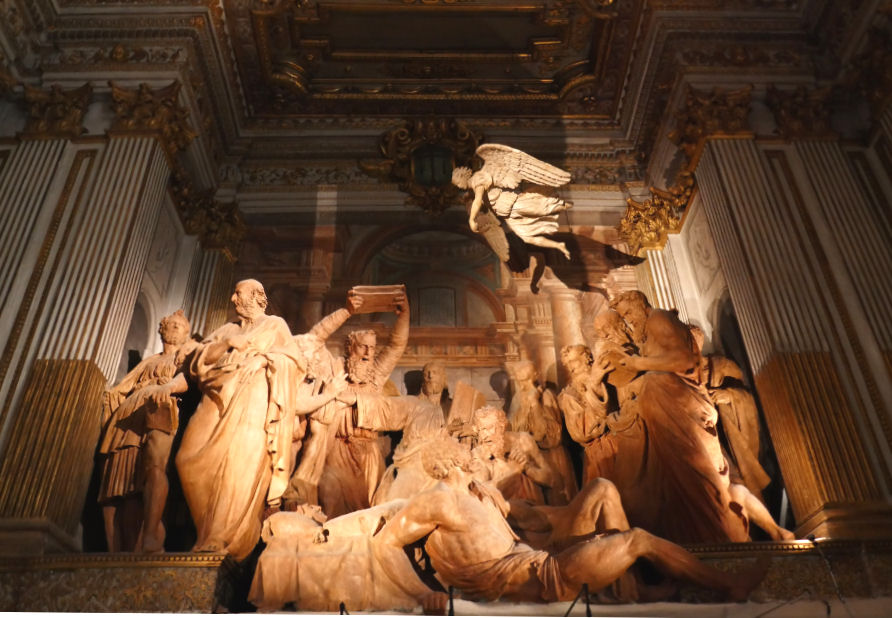 The Oratory Access by staircase to the left of the church, or on the left through the church. (You can buy a joint ticket in the church). This was the meeting place of the Confraternity of the Battuti and the 17th-century rooms now (still?) house a small museum of religious and scientific items relating to the history of the confraternity. The Oratory itself, designed by Floriano Ambrosini, is early 17th century, very gilt baroque, with an ornately enclosed high altarpiece by Nosadella from 1550 of the Virgin and Child with Saints. Around the altar are three more panels, depicting the life of the Blessed Raniero. And you might notice that some of the plaster putti hold little whips. At the opposite end is another, later, 15-strong group of terracotta statues - fifteen of them, over-life-size, on a raised sort-of stage, and the work of Alfonso Lombardi from 1519ľ22 (see photo above) placed here in 1612. It depicts the apocryphal episode of the Funeral of the Virgin, at which a Jewish high priest attempted to overturn the bier but was thrown to the ground by an angel and beaten to death by the apostles. (This being the moment just before the priest is thrown to the ground with his detached hands still attached to the bier, as depicted in the odd painting in San Giacomo dellĺOrio in Venice.) After this one Lombardi completed another terracotta tableau, portraying the moment between the Deposition and Burial of Christ, for the Duomo. The oratory/sanctuary used to have rows of seating facing the tableaux but now has exhibition boards (in 2018 dealing with the city's water works) to above head height, which tended to diffuse the focus and impact.
Opening times The Oratory/Sanctuary Part of the
Genus Bononiae - Museums in the
City cultural itinerary/walk. |
|
|
|
Santa Maria delle Muratelle Via Saragozza |
||
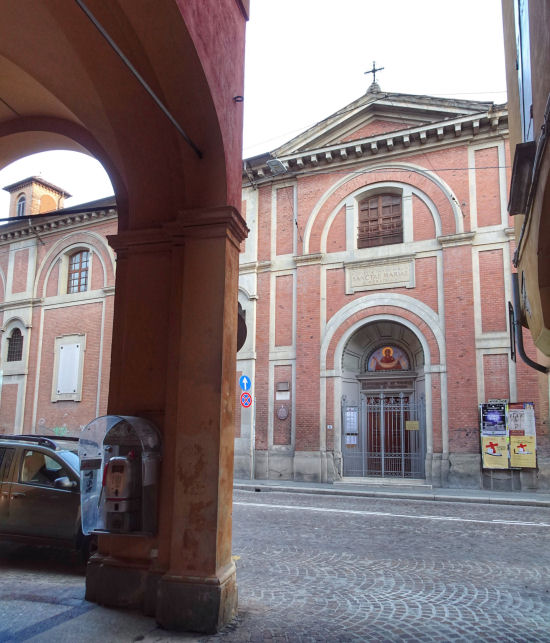 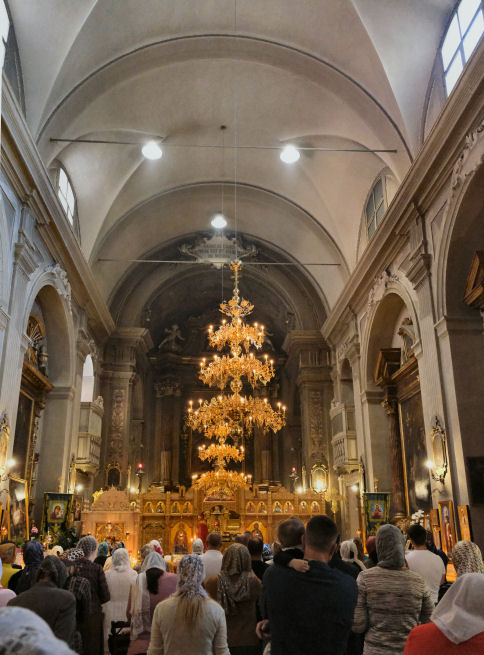
History |
||
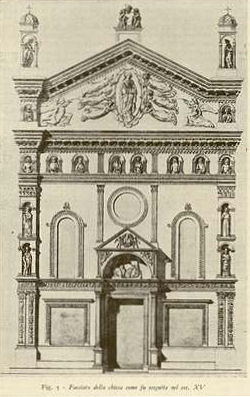 History The first mention of a church here is in a document of 1304 when some friars from Piacenza set up an oratory dedicated to the Holy Spirit here. They were replaced by a charitable order called the Compagnia dei Poveri Vergognosi (Confraternity of the Shameful Poor). The current church was built between 1479 and 1492 to plans by Zilio di Battista to better house a miraculous image of the Virgin, attributed to the school of Lippo di Dalmasio. On the 6th of September 1478 it was said to have cured a man of 'a severe form of the plague'. The wall on which it was painted is preserved in the new building. In 1622 Pope Gregory XV gave the church to the Oratorians of Saint Filippo Neri who are still here. They undertook drastic baroque rebuilding of the interior, to plans by Giuseppe Antonio Torri, in 1684 leaving only the sandstone fašade of 1479 to designs attributed to Egidio Montanari, with eroded sculptures by Donato da Cernobbio. The church suffered bomb damage in World War II, with restoration work in 2014. Interior Very Baroque, aisleless and grey, with some gilt detailing. Three shallow fenced chapels each side, except the first on the left which is deeper and dedicated to San Filippo Neri himself. Mostly 17th and 18th century art. Fleshy 18th century frescoes by Giuseppe Marchesi, mostly depicting episodes from the life of San Filippo Neri, are on the nave ceiling, in the apse semi-dome and on the ceiling of said San Filippo Neri chapel, which also has an altarpiece of The Vision of Saint Philip Neri by Guercino. This altarpiece was delivered in 1647, but fifteen years later Guercino was commissioned by Conte Ettore Ghisiglieri of the Oratorian brotherhood to add the Virgin and 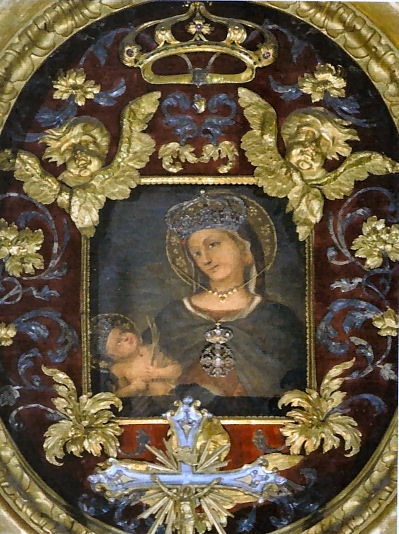 Child to the upper part of the
canvas. Child to the upper part of the
canvas. The second left chapel has Francesco Albani's The Holy Family, the third has an Incredulity of St Thomas by Teresa Muratori. In the fenced-off presbytery is the miraculous Virgin and Child of 1330, remodeled by Franceschini. It was moved here from the San Filippo Neri chapel (first left) in 1597, displacing a sculpted Ascension by the Florentine Nicol˛ Tribolo, which was moved to San Petronio. The high altar of c.1750 was designed by Francesco Galli, called Bibiena. In the second right chapel is a Virgin & Child with Saint Anthony of Padua by Girolamo Donnini and in the third a Virgin and Child with Saints Anne, Francis and Francis of Sales and ten putti by Franceschini, who did the frescoes too. The sacristy, to the left off the nave (not visited) reportedly has paintings by Giovanni Andrea Sirani, Elisabetta Sirani (The Blessed Francis of Sales from 1662), Cesare Gennari and Albani. The interior also has sculptures by Giuseppe Mazza (the stucco angels on the high altar), Angelo Pi˛, and Silvestro Giannotti. 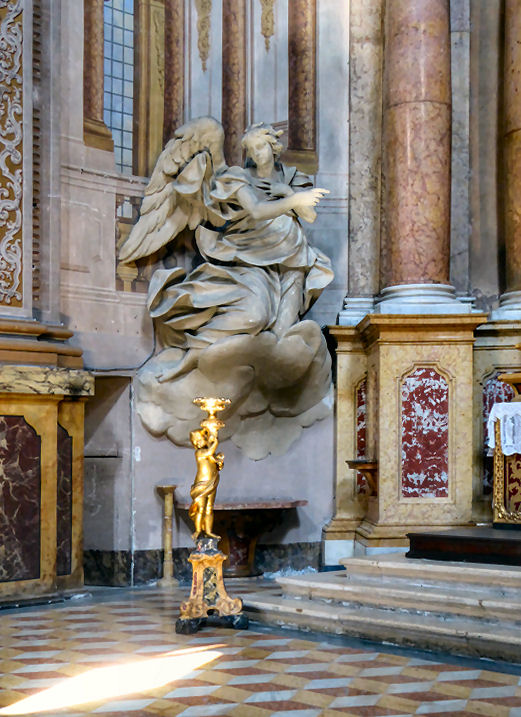 Lost art in the Pinacoteca A detached and damaged fresco fragment of the Virgin and Child by Amico Aspertini from c.1510/15. The pair of Annunciation panels (1588) by Annibale Carracci from the sacristy here, were looted by Napoleon but where returned to the Pinacoteca. Christ Served by Angels by Mastelletta from c.1616. Saint Andrew Corsini by Guido Reni of c.1636. Two small oval panels - Saint John the Baptist and Saint Joseph by Guercino 1644 from the sacristy here. Opening times 7.30 - 12.00 & 13.15 - 14.00 & 16.00 - 19.00 Sunday 9.00 - 13.00
|
|
|
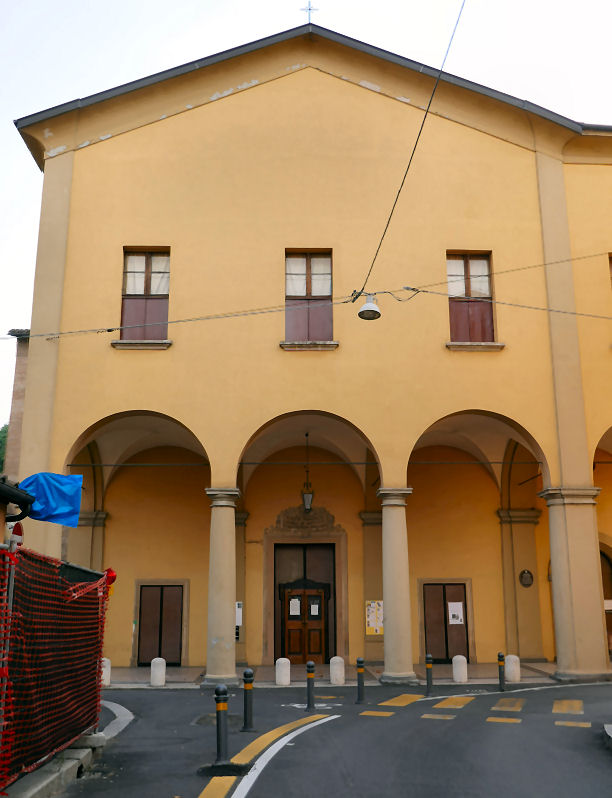 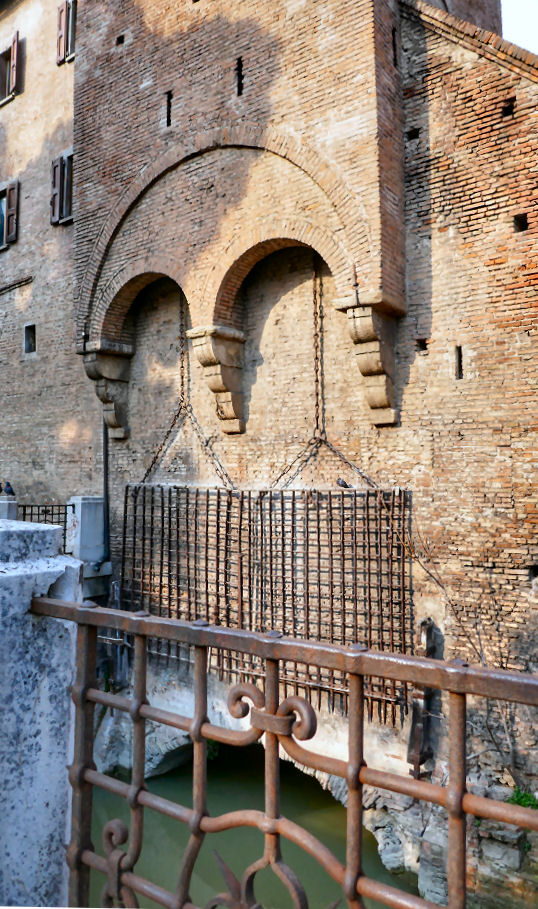 History The current church was built by enlarging an oratory built by the Confraternita di Sant'Antonio da Padova from 22nd May 1632, to designs by Antonio de' Paolucci (known as il Levanti) on the site of a hospital and cemetery, following the plague epidemic of 1630, in order to house and venerate an image of the Virgin which had been on the old city wall above the canal arch. The church houses a relic, the head, of the priest and martyr San Valentino. Its name derives from the metal grille (grada) (see right) under a 14th century tower, lowered to block an arch through which the major Reno Canal entered the city centre, which was used to foil enemies and smugglers entering the city walls.
Paintings by A. Catalani, P. Fancelli, G. Caponeri
|
||
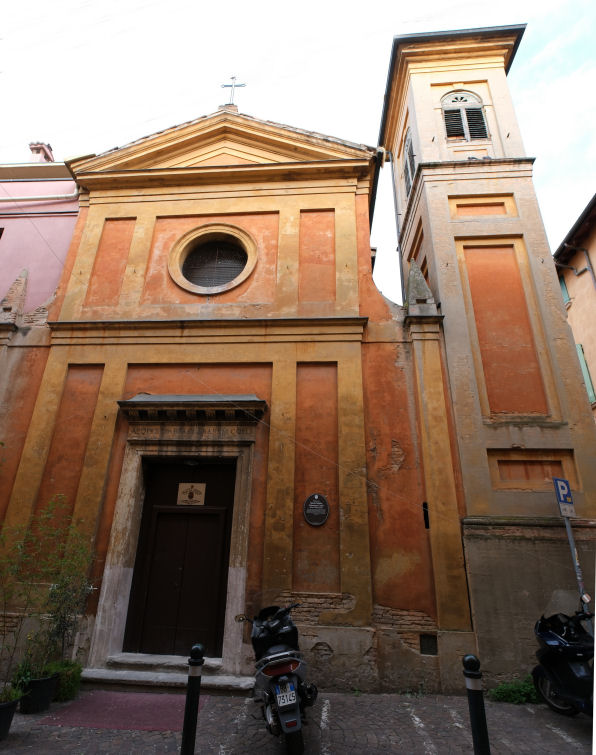 History Built in 1780, on the site of churches dating back to the 13th century, to designs by Angelo Venturolli. The church being called La Baroncella is a corruption of Labarum Coeli. Used by the Eritrean Orthodox community since 2006. Interior Has an altarpiece of The Immaculate Conception by Gaetano Gandolfi and stucco reliefs by Giacomo Rossi |
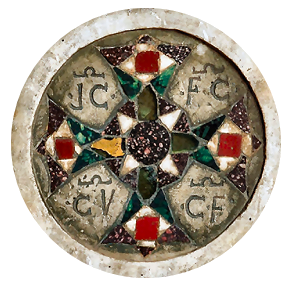 |
|
|
Santa Maria Maddalena Via Zamboni |
||
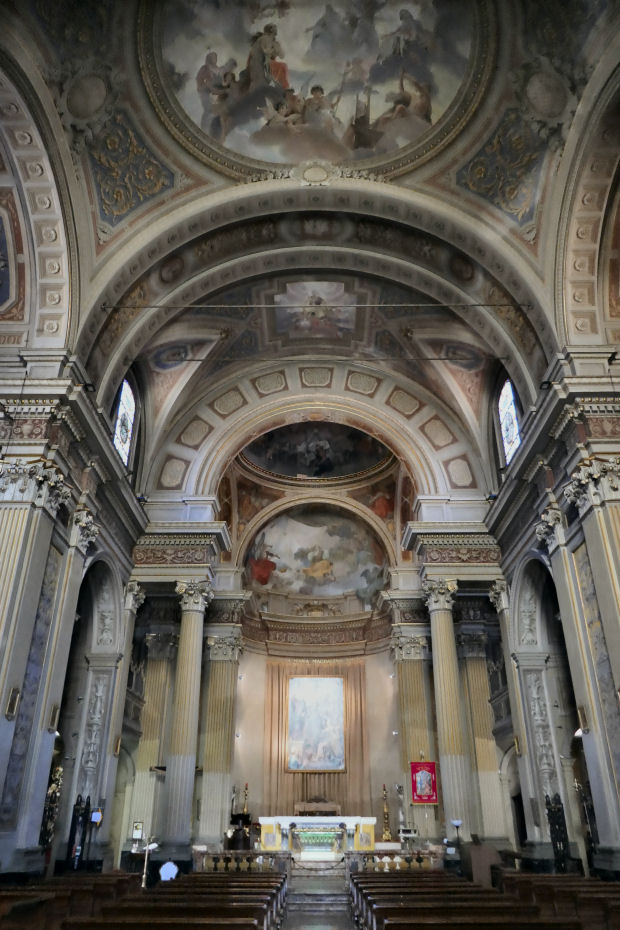 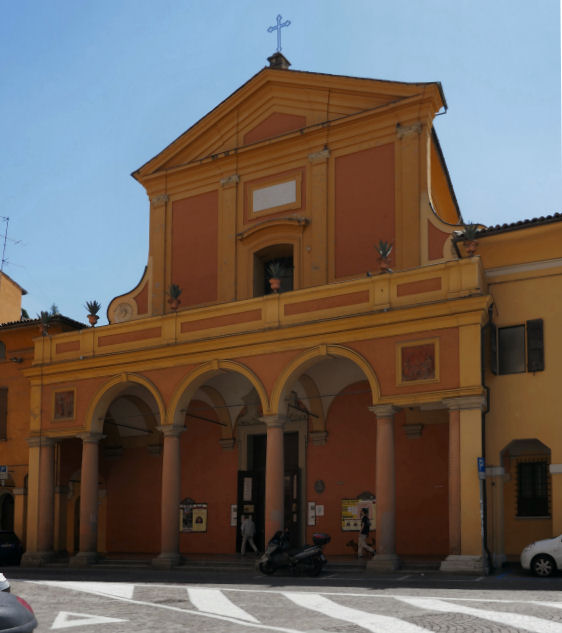 History There is said to have been a church here in 1187. Nuns of the order of Santa Caterina di Quarto moved to a convent came here in 1291, leaving in 1668. A late-16th-century replacement church was itself demolished and the church completely rebuilt 1761-63 to designs by Alfonso Torreggiani, carried out by Raimondo Compagnini, who designed the portico, with modifications in 1835 by Vicenzo Vannini. Interior Small, dark, grey with gilding, and all surfaces decorated, with three, small-large-small, chapels each side of the nave. The painted panels in the ceiling arches correspond with the chapel widths. There's a 19th century presbytery in a crossing of sorts with an organ loft and gallery over the arms, a dome and a shallow apse with a painted semi dome. Ceiling frescos date from 1905 and are by Domenico Ferri. The high altarpiece is a striking Conversion of Saint Mary Magdalene by Francesco Cavazzoni, signed and dated 1580. There's an unusual amount of stained glass, in clerestory windows. Mostly 18th century paintings (and some works in painted stucco) by the likes of Gandolfi, Mazza, Cignani and Passerotti. There's a Virgin and Child panel here too, attributed to Lippo di Dalmasio, of course. Opening times 8.00 - 12.00 & 4.30 - 7.00 August - only on Sundays for Holy Mass.
An 18th-century print by Pio Panfili A photo taken during the orti di guerra scheme in 1942. |
||
|
History Legend has a church here in the 5th century rebuilt, with the addition of a campanile, and reconsecrated in 1187. The Basilica was in the care of Benedictine nuns until July 31, 1243 when they where suppressed by OttaViano Ubaldini, then administrator of the Diocese and a cardinal, who is mentioned by Dante Alighieri in the Divine Comedy. The church was enlarged in 1464, with the help of the Bentivoglio, involving an extension by two bays and the addition of a coffered ceiling and a new facade. The current church dates to rebuilding by Paolo Canali in 1665, which replaced the coffered ceiling with a vaulted one and involved the rebuilding of the facade portico with a first floor accommodation used as a rectory. The Bolognese Pope Benedetto XIV Lambertini, as stated on a tombstone of 1752 on the counter-fašade paid for a new roof, the extending the main chapel greater, with a new marble high altar designed by Alfonso Torreggiani. Closed after the 2012 earthquake, work followed, and was completed. Interior Reportedly has paintings by Francesco Carracci (The Virgin and Saints), Alessandro Tiarini (The Mystery of the Rosary), both in the first chapel, Vicenzo Spisanelli (The Death of Saint Joseph in the fourth chapel), Mauro Gandolfi, Pietro Fancelli, Jacopo Alessandro Calvi, and Alessandro Guardassoni. The chapel of the Holy Sacrament was stuccoed by A G Pio. The high altar (1749) is attributed to Alfonso Torreggiani. The presbytery was enlarged at the expense of the Alamandini family c.1573, with an altarpiece of The Circumcision by Giovanni Francesco Bezzi called il Nosadella, completed by Prospero Fontana after Nosadella's death in 1571. The altarpiece which depicts the Virgin and Child with Saints James Minor and Anthony Abbott by Orazio Samacchini (c.1564) was commissioned by the Tanari for their chapel in the right aisle. Lost art A Stone Cross dated 1143, making it the oldest of the Bolognese roadside crosses, was discovered during work on the pavement of the porch of the church in 2013. Now exhibited in the Medieval Museum. Opening times Only for services |
|
|
|
Santi Bartolomeo e Gaetano Strada Maggiore |
||
|
History Tradition claims a church was built here in the 5th century by Saint Petronius. But the first written evidence dates to 1288 with a church built by Benedictines and housing a group of nuns. In 1516 the church was demolished to be replaced by a palazzo for prior Giovanni Gozzardini and a rebuilt church, the work entrusted to Andrea da Formigine in 1516. When Gozzadini was assassinated the following year the work was interrupted - the portico and doorway of this building remain along the south side of the nave. In 1627 the Theatines acquired the building and had the church rebuilt, firstly by Giovan Battista Natali and later by Agostino Barelli, moving the fašade from the square to the Strada Maggiore. The order also commissioned from Marcantonio Franceschini and Luigi Quaini ten lunettes for the portico and renamed the church in 1671 for their just-canonised founder Saint Cajetan, although it's locally usually known as San Bartolomeo.
Interior |
|
|
|
Santi Filippo e Giacomo Via delle Lame |
||
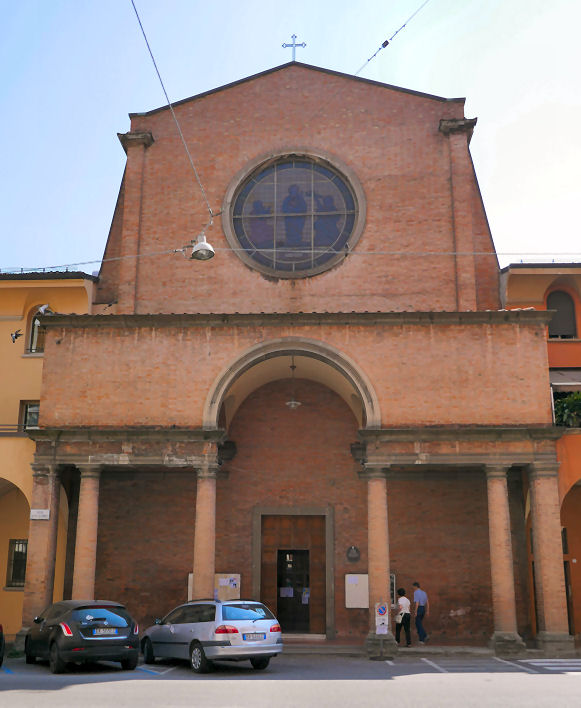 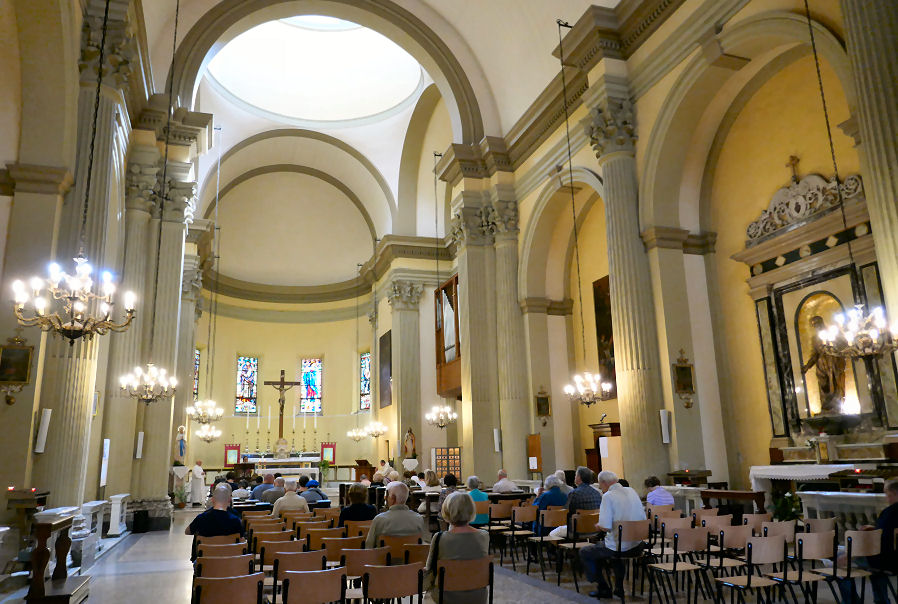 History Built in a baroque style in 1641 by Francesco Martini. Part of a complex housing Capuchin nuns until 1802. Serious bomb damage in 1944 and rebuilt in the 1950s by architect Luigi Vignali. Interior Small, tall, pale, no aisles, three shallow bays each side separated by fluted semi-Corinthian columns as usual. Domed crossing Works remain by GF Gessi, Alessandro Tiarini, B. Passarotti, G. Cavedoni, V. Spisanelli and other 17th-century artists. Opening times Monday - Friday 7.30 - 11.00 & 16.30 - 19.30 Saturday 9.00 - 11.00 & 16.30 - 19.30 Sunday 9.00 - 11.30
|
||
|
Santi Giuseppe e Ignazio Via Castiglione |
||
|
The church also hosts concerts performed by its resident choir.
|
||
|
|
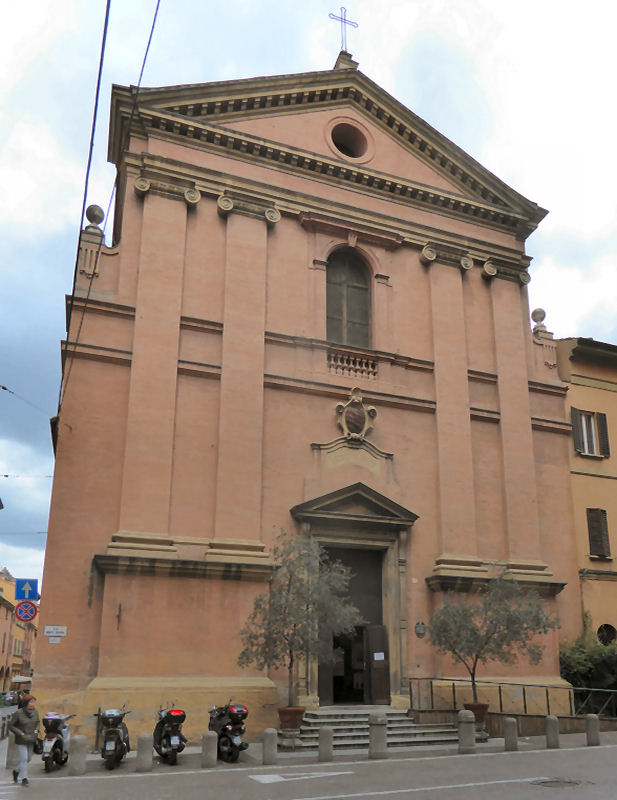
|
|
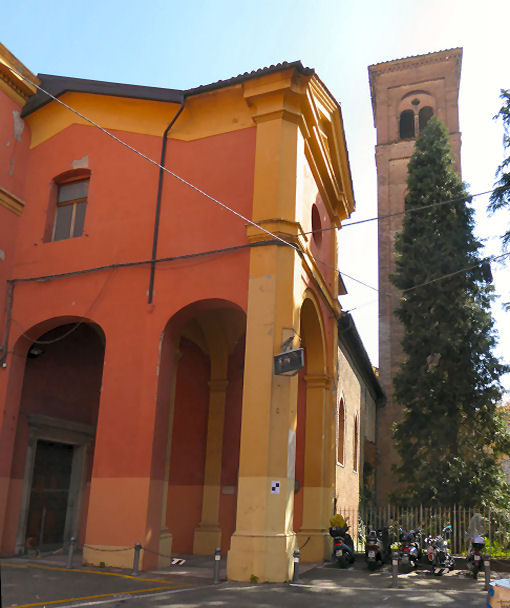 Click here for the website to book San Zama crypt visits |
History The crypt of San Zama here is believed to have been part of Bologna's first cathedral as the remains of the first bishops of Bologna, starting with Zama himself, were buried here, until the 8th/9th century (except for San Petronio who is buried in Santo Stefano). It's more likely that one of the first Christian cemeteries was here, and it was where the bishops of Bologna were buried because of the ban (until the 5th century) on burying the dead within the city walls. Faustiniano, the bishop after Saint Zama, built a larger church here and renamed it Santi Naborre and Felice, after two 4th-century Berber Milanese martyrs. After 1000 Benedictine monks rebuilt the church here in Romanesque style, building the crypt, a monastery and, during the 14th century, the bell tower and the sacristy. In the 15th century the monastery got mixed up in conflict between the Bolognese aristocrats and the papacy, which resulted in abandonment by the Benedictines and the consequent ruin of the complex. After a century of decline the pope gave the complex to Clarissan nuns. The crypt is the only surviving Romanesque part of the complex. The layout of the crypt today is the result of work carried out by the Clarissans. who decided to separate it from the building above. Supporting pilasters were inserted into the columns, dividing the crypt into three naves, which all end in semicircular apses. Lost art in the Pinacoteca A polyptych by the pseudo-Jacopino (see below) from c.1340. 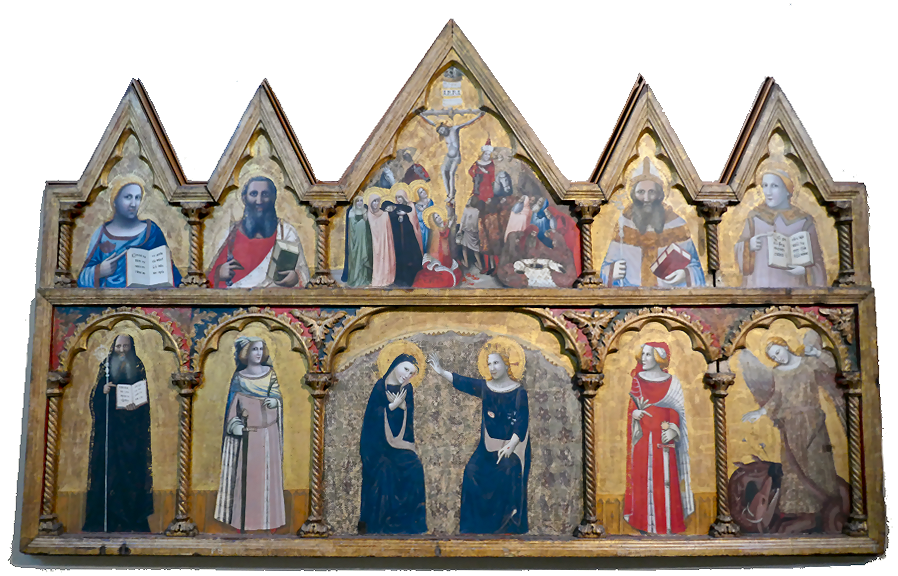 A softly mannerist Virgin and Child with Saints John the Baptist, John the Evangelist, Francis, Clare, Catherine and Mary Magdalene by Giovanni Battista Ramenghi (Bagnacavallo Junior) signed and dated 1563. A Coronation of the Virgin with many, many saints by Orazio Samacchini frm the 1570s. |
|
|
Santi Vitale e Agricola Via San Vitale |
||
|
History A church here was rebuilt by Benedictine nuns during the late 16th century, with work finishing, and consecration, in 1641. The atmospheric crypt which remains dates to the original building of the 11th century, and was used by the nuns. Suppressed by Napoleon, the complex was sold and partially demolished, with the rest being converted into a palazzo, with the crypt used as a grotto where the literary circle of the Countess Cornelia Barbara Rossi di San Secondo met. The parish was re-established in 1824 and church was restored, with the facade added in 1872/3 and the crypt rediscovered in 1890 and reopened two years later. The dedication is to the two saints, Vitalis and Agricola, slave and master respectively, who were martyred in 304 under Diocletian in Bologna's Roman amphitheatre which is thought to have been in this area, or even precisely on this site, where legend has a commemorative church built in 340. Saint Ambrose discovered their bodies in 392, in a nearby Jewish cemetery, and had them exhumed and reburied here. In 1019 they were moved to the crypt of Santo Stefano, in 1060 they were transferred to the Duomo's crypt, in 1578, they were divided between Santo Stefano and the Duomo. So now the crypt of Santo Stefano has two urns - one contains the skull of Agricola with a few bones, the other has a few bits of S. Vitalis, but most are in an urn in the Duomo. Their saint's day is November 4th. Interior Rather dark - an aisleless nave with four arched spaces on the right, but only the middle two are chapels. The first is the entrance to the sacristy, the forth has the stairs down to the crypt. On the left the third and fourth bays are a chapel and a storage space. The high altarpiece is the Martyrdom of Saints Vitale and Agricola by Luigi Busi from 1876. The chapel of Santa Maria degli Angeli, through two arches off the left of the nave, was a small late 15th-century church, with a doorway to the street (supposedly the work of Andrea Marchesi, called il Formigine). This chapel was the work of Gaspare Nadi and was amalgamated into this church during the 16th century rebuilding. On the right wall is The Flight in Egypt by Alessandro Tiarini. The altarpiece has, in the centre, an elliptical copy of a Virgin and Child which was by the Sienese painter Sano di Pietro, the original having been stolen in 1972. To the left is The Visitation by Bartolomeo Ramenghi (il Bagnacavallo) and on the right The Nativity attributed to Francia. In the last chapel on the right, towards the apse, are stairs down to the atmospheric rough-brick crypt (see below) where you put Ç1 in the slot for the lights before tripping downstairs. The crypt, a nave and two aisles ending in apses, contains the saints' remaining remains - after Ambrose had their bodies reburied here he spread their cult by giving some bits of them to Rouen and Florence. There are bits of old buried wall down there too. 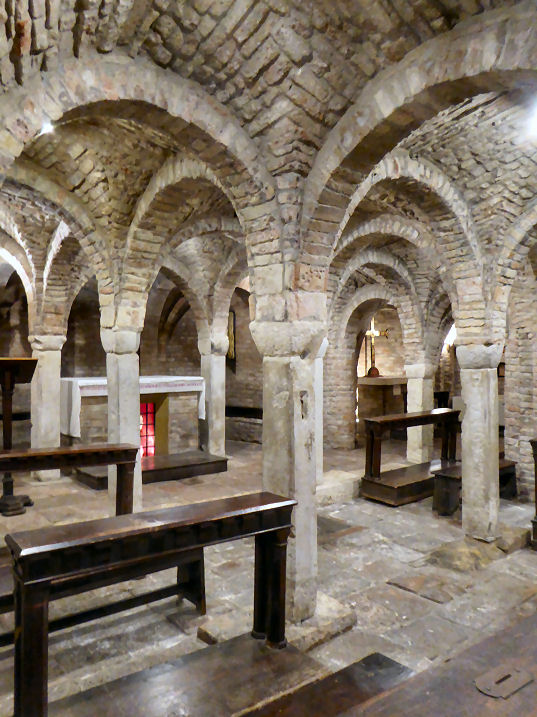
Lost art
|
|
|
|
|
||
|
Santissima Annunziata Via San Mamolo |
||
|
History 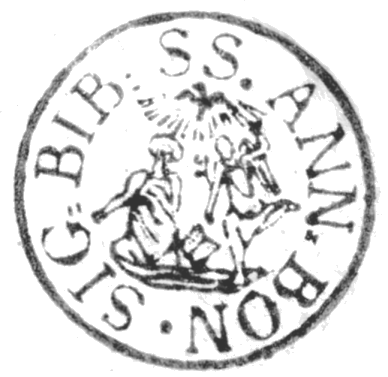 Built in 1304 by Armenian Basilian monks, passing in 1475 to the Observant Franciscans who rebuilt. Used as a lazaretto during the plague of 1630. During the 17th century the interior was remodelled in gothic style and in 1690 the campanile was built. In 1810 church and convent were suppressed and made into a prison. In 1816 the friars returned, only to be evicted again in 1849, and to return in 1850. Suppressed again in 1870, the church became an arms depot. Restored by the army to the friars in 1944 to return to religious use, after the war they briefly moved back in, before giving the complex back again. In the 16th century porch leading to the entrance there are fifteen lunette frescos of 1619 by Giacomo Lippi, a pupil of Lodovico Carracci, and Paulo Carracci, the younger brother of Ludovico. They are about as ravaged as you'd expect but some are pretty intact (see below). 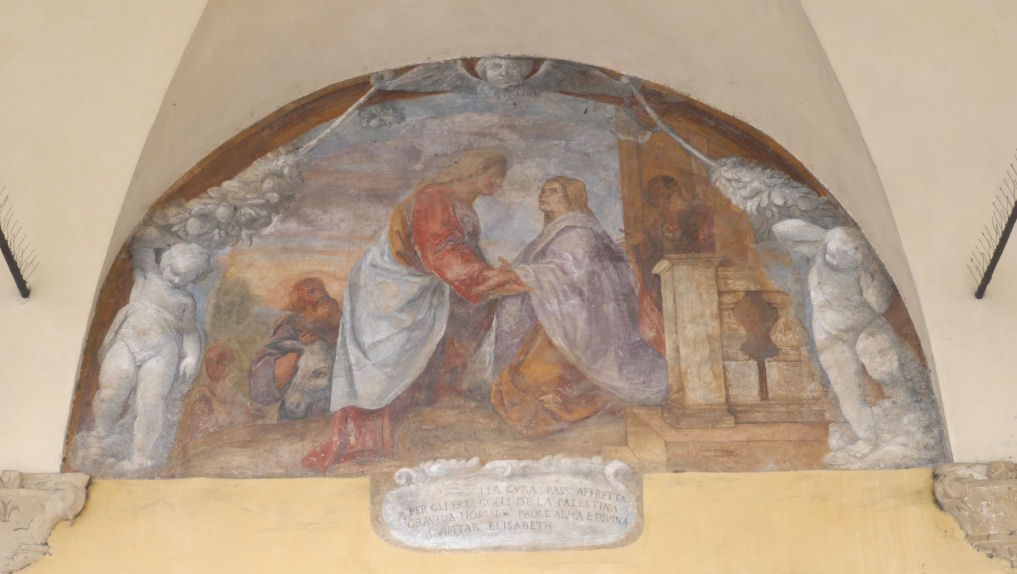 Interior A nave with two aisles and a dome of 1488. Brick columns, singles alternating with clusters of four, and brick thin-ribbed vaulting. No side chapels or altars. In the apse there's a frescoed semi-dome of trompe l'oeil architecture and The Glory of San Francesco by Angelo Bigari and Davide Zanotti from end of 18th century, with stucco sculptures of the prophets Isiah and Geremia by Giacomo Rossi (1792). An Annunciation altarpiece by Francesco Albani. Eleven Franciscan saints in the windows down the right side - so lots of brown glass. Unlit detached fresco of The Adoration of the Magi 1524 on the wall of the left aisle is by Biagio Pupini. Nearby altarpieces are one copy and two more modern paintings. 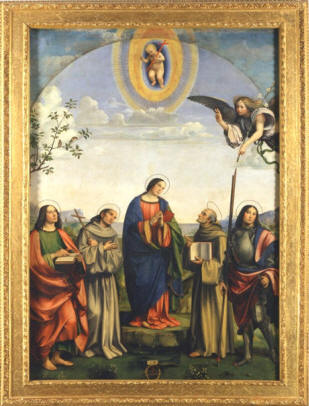 Lost art now in the Pinacoteca Formerly the high altarpiece here, an Annunciate Virgin with Saints John the Evangelist, Francis, Bernardino, and George and a separate God the Father panel, of 1500 by Francia (see right). A Virgin Enthroned with Saints Paul, Francis and the Young John the Baptist also by Francia, painted for the Scappi chapel here c.1495. Three by Lorenzo Costa: symmetrical and serious Saint Petronius Enthroned with Saints Francis and Domenic from 1502; a Burial of Christ by him, and his studio, from around the same time, and a Marriage of the Virgin with Saints Joseph and Anna and Franciscan brothers - the last one painted for the Gessi chapel here.
Opening times
|
|
|
|
Santissima Trinita Via Santo Stefano |
||
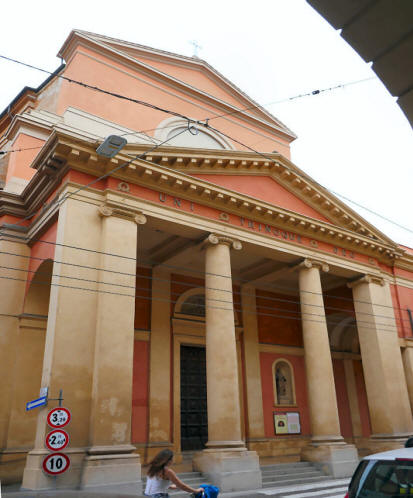 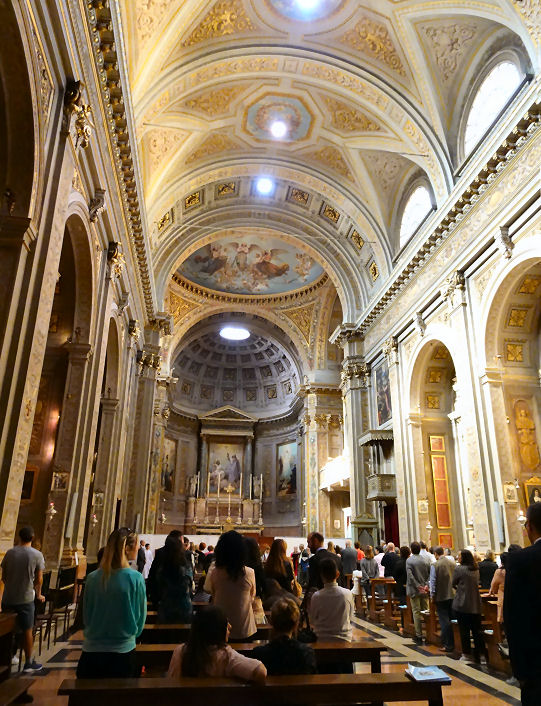 History When nuns of the Gesuati Order had outgrown their previous convent (whose church had been consecrated in 1480) they bought up land here, between 1634 and 1648, and the first stone was laid in 1662. The plans for this new church were the work of Bolognese architect Francesco Martini. Delays and interruption to the work led to it not being consecrated until 21st June 1750. The Napoloeonic suppressions of 1797 resulted in much to-ing and fro-ing of monks, nuns and parish jurisdiction between this complex, the Augustinian monks of San Biagio and the nuns of San Pietro Martire, before parish of SS Trinita was properly established in 1806. The portico on the facade is 19th-century and was designed by Enrico Brunetti Rodati.
Interior |
||
|
Santissimo Salvatore Via Cesare Battisti |
||
|
History The original church here is said to have been established by the 8th century, by a group of Greek monks fleeing from the east due to iconoclastic persecution who settled here and founded a church dedicated to the Saviour. The Order of the Canons Regular of Santa Maria di Reno were here from the 12th century, and rebuilt in 1474 to designs by Gaspare Nadi. The church became popular with English university students and a chapel was added dedicated to Thomas Becket, who had studied law in Bologna. The current church dates to a total rebuilding of 1605ľ23 by father Giovanni Ambrogio Magenta, a Barnabite and the architect Tommaso Martelli. The convent was suppressed in 1866. The rectors of the church remain the Canonici Regolari Lateranensi. Fašade Three copper statues by Orazio Provaglia top the fašade, the niches have terracotta statues of the Evangelists by Giovanni Tedeschi.
Interior
Opening times
|
|
|
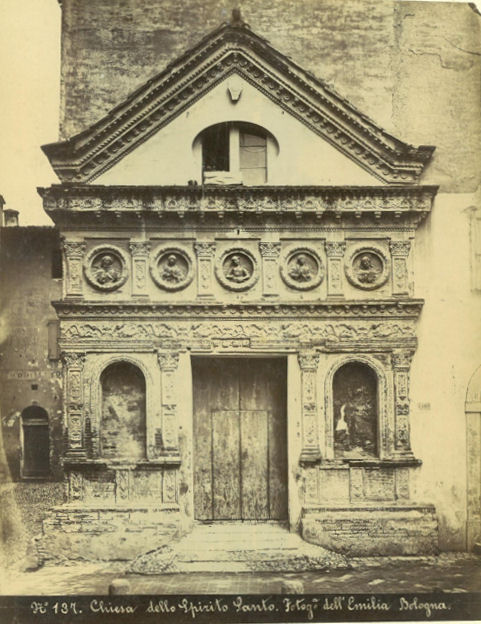 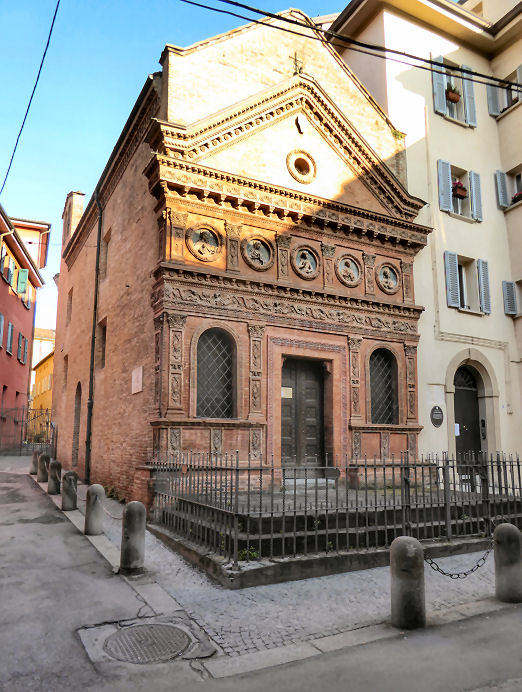 History The terracotta facade from the 15th century, with its five tondi of saints, has been attributed to Vincenzo Onofri or to Sperandio of Mantua. Built from 1481 to 1497 for Celestine monks from the nearby monastery of San Giovanni Battista to house a Marian icon, the oratory transferred to the Compagnia dello Spirito Santo in 1497 and was suppressed in 1798. It suffered much, losing its high altarpiece, a work of 1567 by Giovanni Battista Ramenghi. Much-needed restoration (see pre-restoration photo right) was carried out 1892/93 by the ubiquitous Alfonso Rubbiani, during which the original polychrome was recovered. During later renovation in 1965 the remains of a Roman floor were found under the presbytery.
From
Guarda che luna by
|
||
|
Santo Stefano Via Santo Stefano |
||
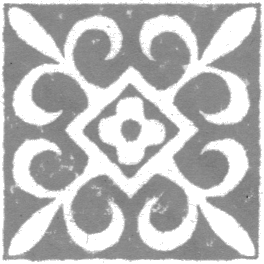 Lost |
||
|
San Giorgio Lost art in the Pinacoteca An Annunciation (1584) with a very young-looking Virgin, and a Miracle of the Pool by Lodovico Carracci (c.1595). A Virgin and Child Enthroned with Saints John the Evangelist and Catherine and the young John the Baptist by Annibale Carracci 1593 from the Landini chapel here. A Baptism of Christ by Francesco Albani c.1620/1624 from the Cingari and Fabri chapel here. San Lorenzo 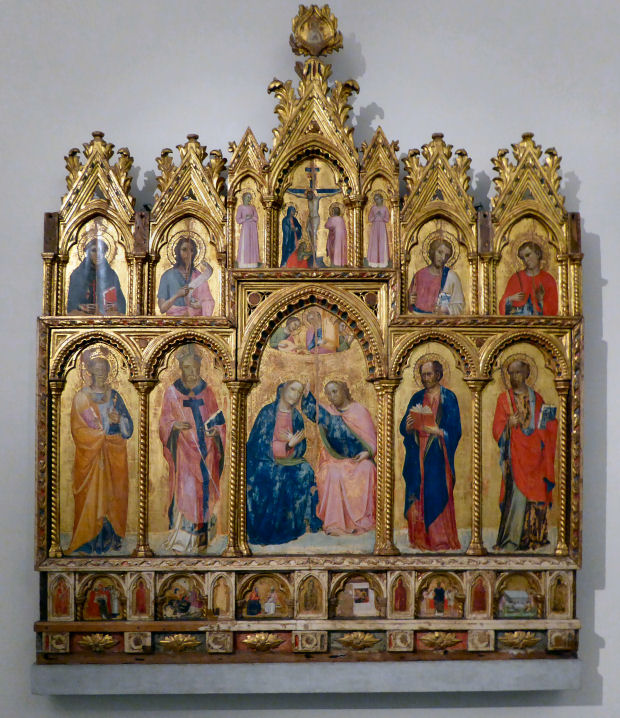 A convent of Cistercian Ursulines. Lost art From a frieze of 16 scenes of the Passion the Ferrara Pinacoteca has the Christ Carrying the Cross and Crucifixion panels, tempera on canvas, from the mid 15th century by a Northern Italian artist. A very Bellini-inspired Virgin and Child with Saints Lawrence and Jerome and Two Music-Making Angels by Francesco Francia from 1500 is in the Hermitage. San Marco Lost art A large and sweet Coronation of the Virgin polyptych of around 1380 by Giovanni da Bologna (see right), now in the Pinacoteca. |
San Pietro Martire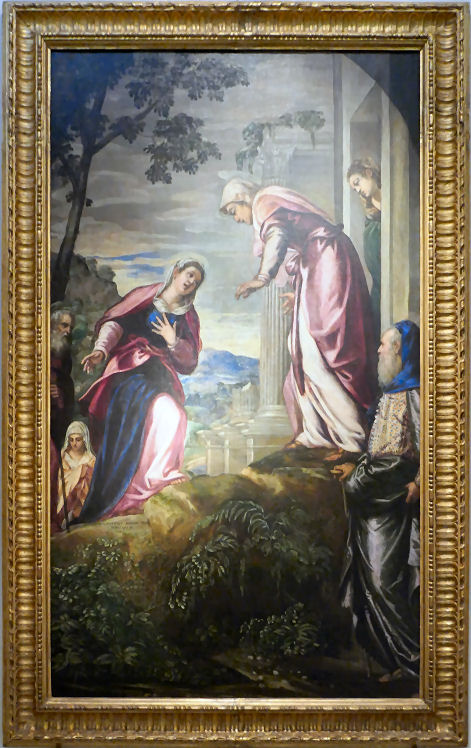 History Augustinian church and convent built in 1290 passing in 1474 to Dominican nuns. In 1595 a new church and campanile by Andrea Ambrosini was begun, and was consecrated on the 10th of July 1613. On August 16th 1808 the church was closed. Lost art in the Pinacoteca A polyptych by Michele di Matteo from 1462. The Visitation with Saints Joseph and Zaccaria (c.1550) (see right) by Jacopo Tintoretto. A Transfiguration by Ludovico Carracci of 1595 from the high altar here. A Resurrection of Christ by Bartolomeo Passerotti from 1575.
|
|
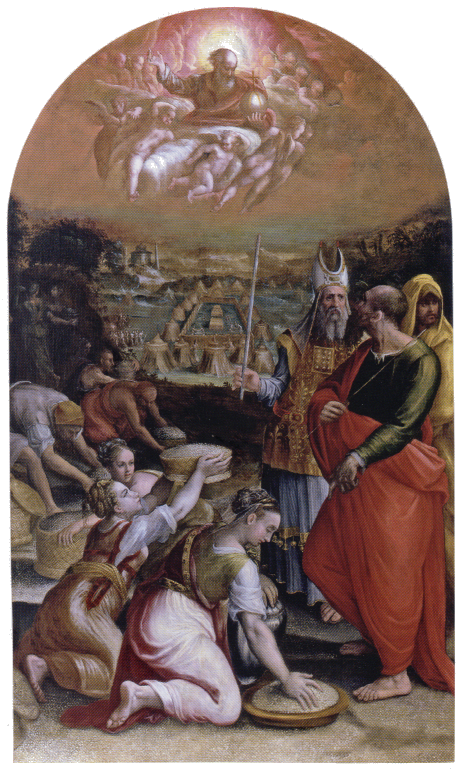 Sant'Agnese Sant'AgneseHistory A Dominican convent founded around 1223 by Suor Angelica, she having reputedly collected information from Saint Dominic himself to write a (now lost) biography. The convent grew large and became important in Bologna, but was abandoned in 1799. Lost art The Martyrdom of Saint Agnes by Domenichino, admired by Ruskin. The Gathering of Manna of c.1568-70 by Prospero Fontana (see right) now in the Pinacoteca, is unusual in being an altarpiece main panel of an Old Testament story. There's an Assumption by Guido Reni from c.1596/97 which unusually includes Saint Agnes and, along with Reni's being a repeated painter of choice for the Dominicans, has prompted provenance theories pointing to this convent. There is no proof, however. It's now in the Klesch Collection Sant'Apollonia di Mazzaratta Santa Margherita Lost art in the Pinacoteca. The Giusti chapel here had Parmigianino's Virgin and Child with Saints Margaret, Jerome, and Petronius of c.1529. It had originally been painted for the high altar, where it only stayed for a couple of years. The Death of Saint Benedict by Domenico Maria Canutti was here before 1671 when Malvasia saw it under the portico. Santa Maria delle Rodini Lost art Had a Lorenzo Costa altarpiece, a Presentation at the Temple, formerly in the Berlin Kaiser-Friedrich Museum, destroyed in the Friedrichshain Flakturm fires of 1945, except for the pilaster panels now in Atlanta's High Museum of Art. |
Sant'Ignazio History The Jesuit novitiate and church of Sant'Ignazio was built between 1727 and 1735 to designs by Alfonso Torreggiani. Following the Napoleonic suppression of the religious orders the Accademia di Belle Arti, formerly the Accademia Clementina, began collecting the art from the suppressed churches, and their need for more space led, in 1803, to their moving from the Palazzo Poggi to this nearby complex of Sant'Ignazio. It is now the Pinacoteca Nazionale. The ceiling of the main staircase to the exhibition halls in the Pinacoteca has a fresco of the Glory of Saint Ignatius by the Jesuit painter Giuseppe Barbieri, this being the site of the former convent chapel.
|
|
|
Santi Girolamo ed Eustachio |
||
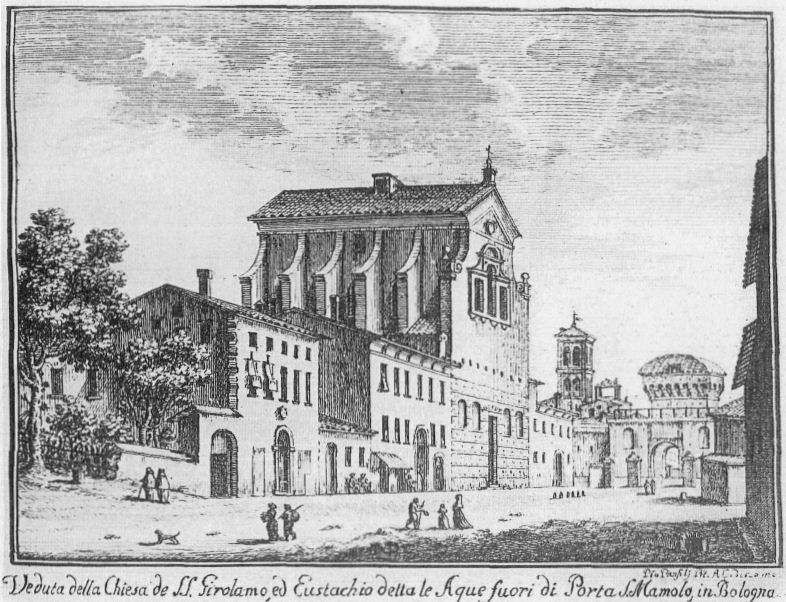 History History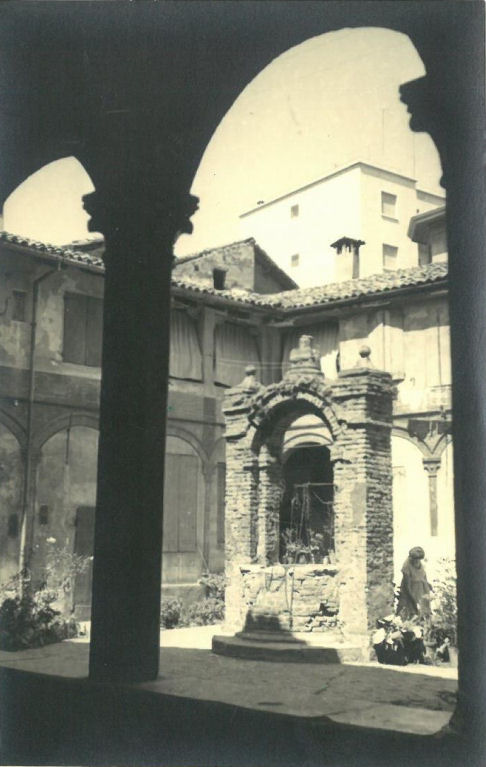 Santi Girolamo and Eustachio, called Badia delle Acque, stood in front of the church of the SS. Annunziata. The church and the convent was initially the seat of Jesuit monks, who had it from Niccol˛ Albergati, the Bishop of Bologna, and were here from from 1379 to 1668, when the order was abolished. (But this reported granting to the Jesuits seems to date to when Albergati was around six years old.) The friars were said to have made excellent perfumed waters. The complex then passed to the Olivetan monks of San Michele in Bosco until the Napoleonic suppression of 1797. This church, designed by Girolamo Rainaldi and built from 1628-46, was destroyed in a fire of 1859. What remained was sold to private individuals and turned into housing. Today only the 15th century cloister remains (see right), with a central well in the inner courtyard of 5-21 in Via San Mamolo. Traces can also still be found just outside Porta San Mamolo, at the beginning of the road on the right, at the intersection with Viale Aldini. Lost art The Virgin and Child Enthroned with Saints John the Baptist, Jerome, Francis, George, Sebastian and Eustace and Two Devotees (Pala del Tirocinio) (see below), the damaged high altarpiece from 1504/05 by Amico Aspertini is today in the Pinacoteca Nazionale.
|
||
|
|